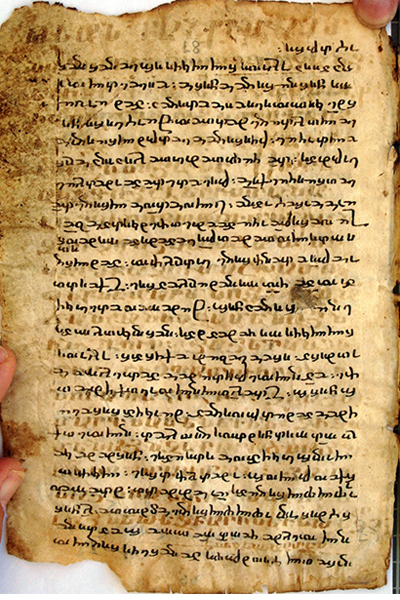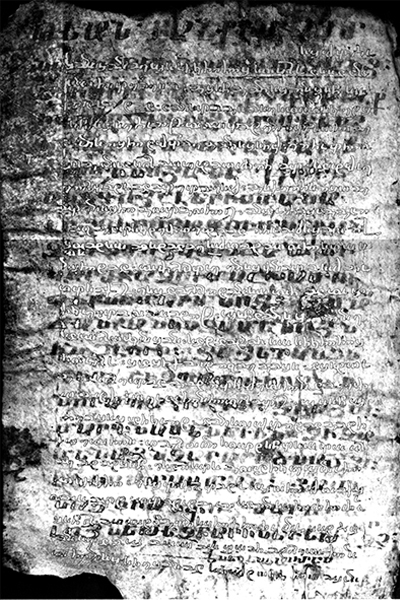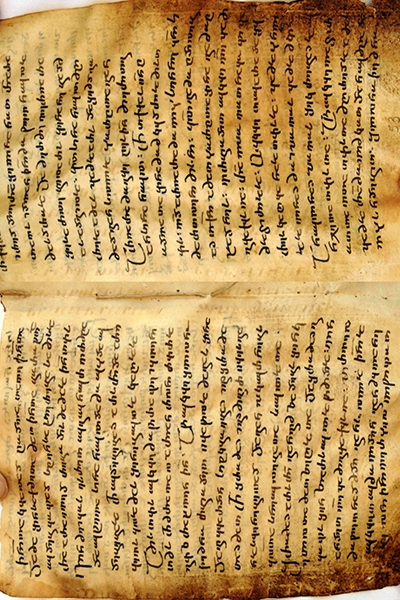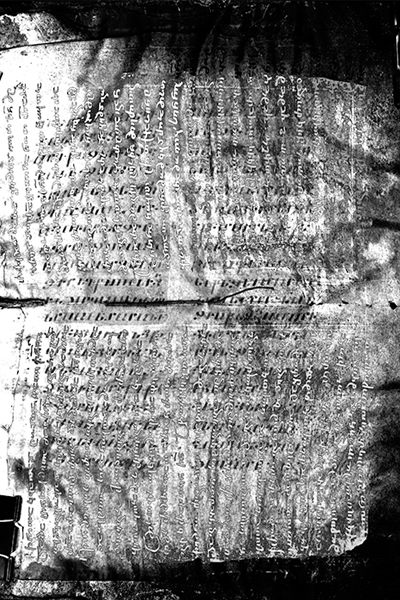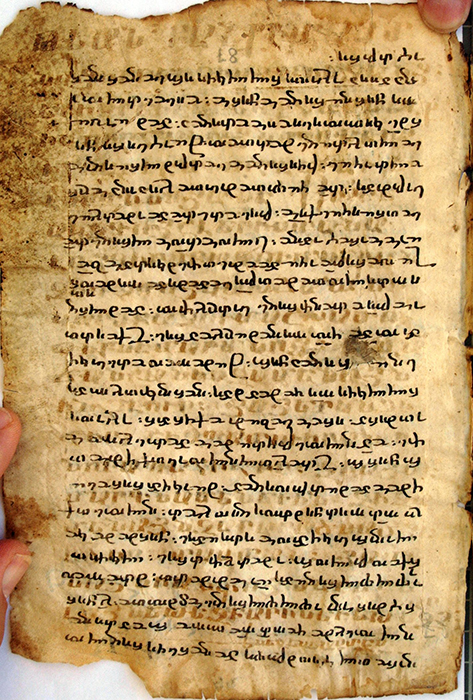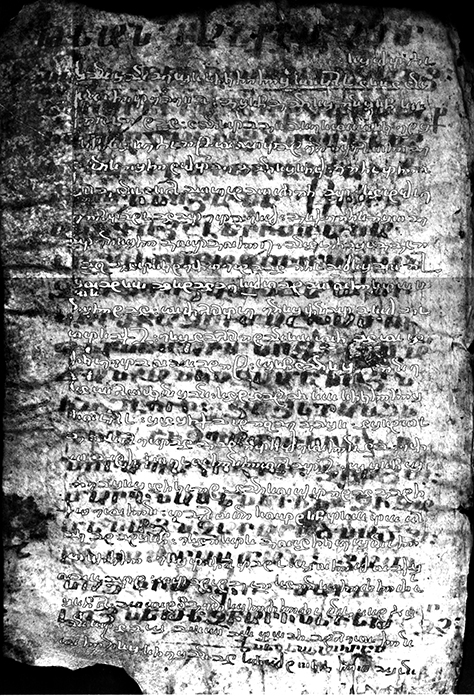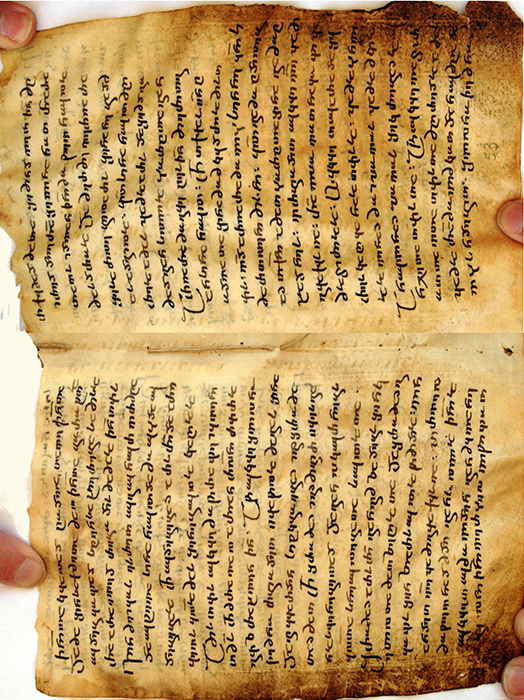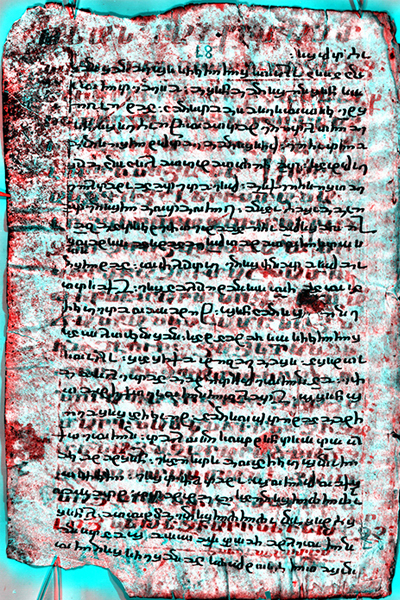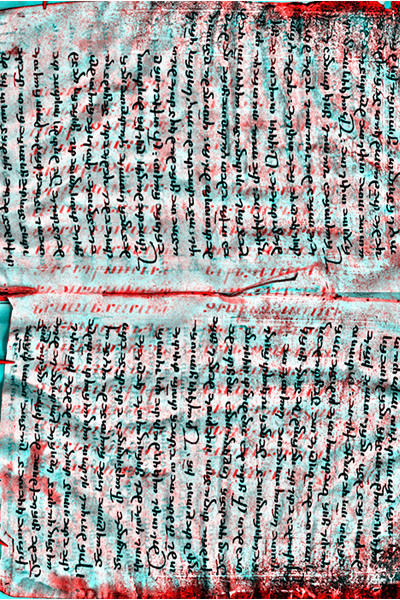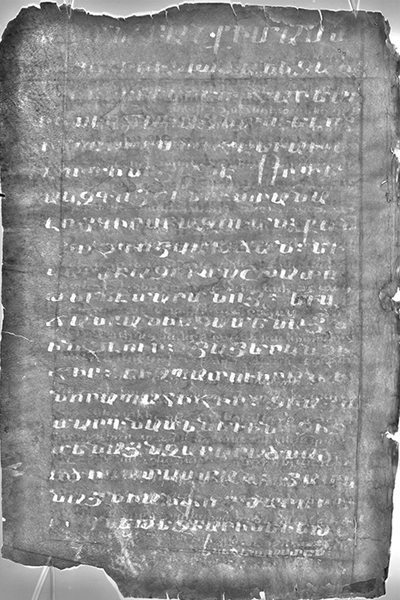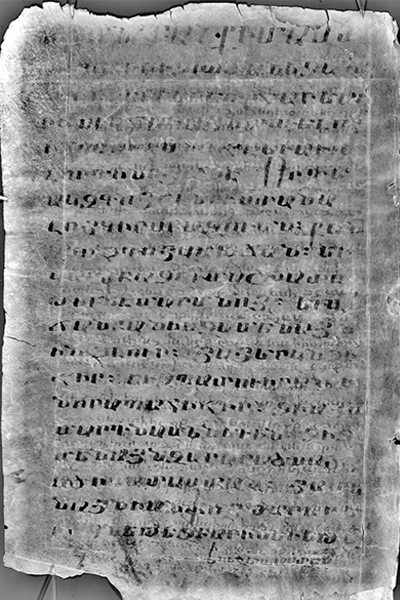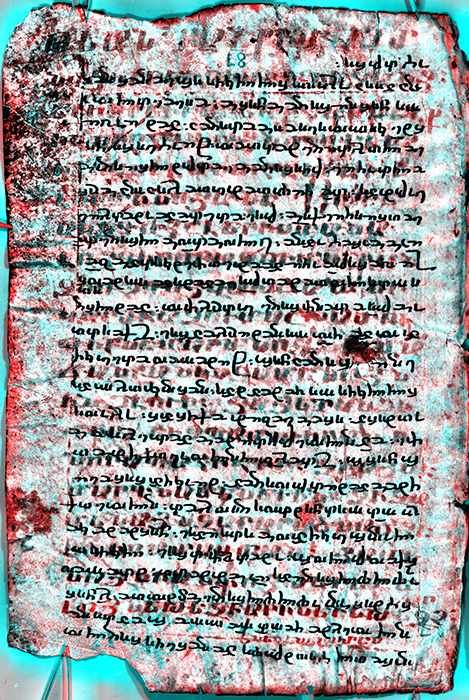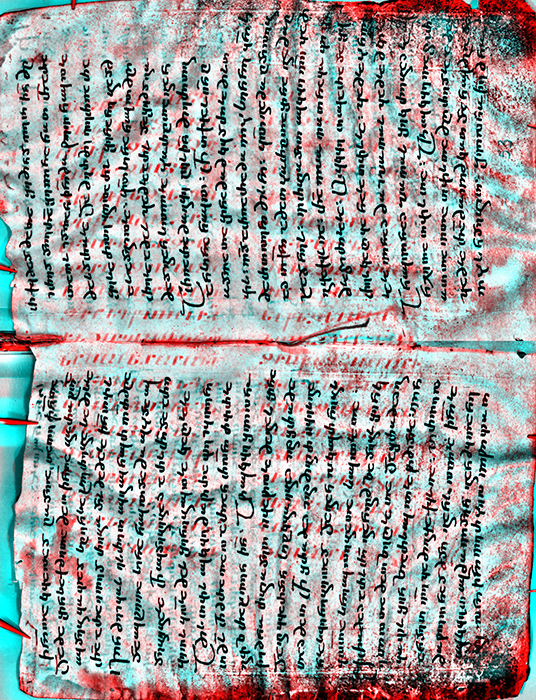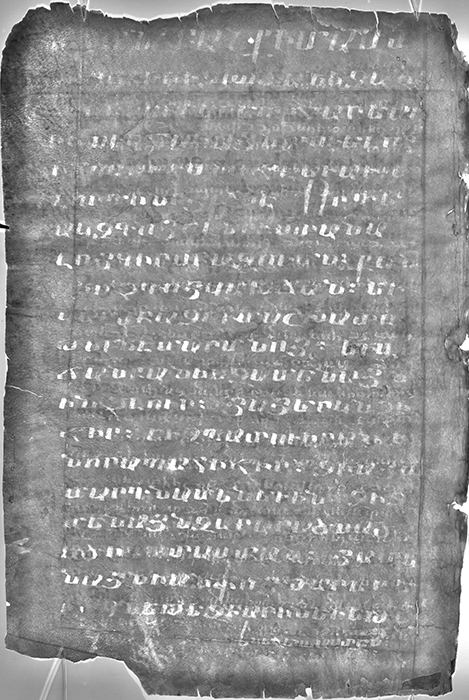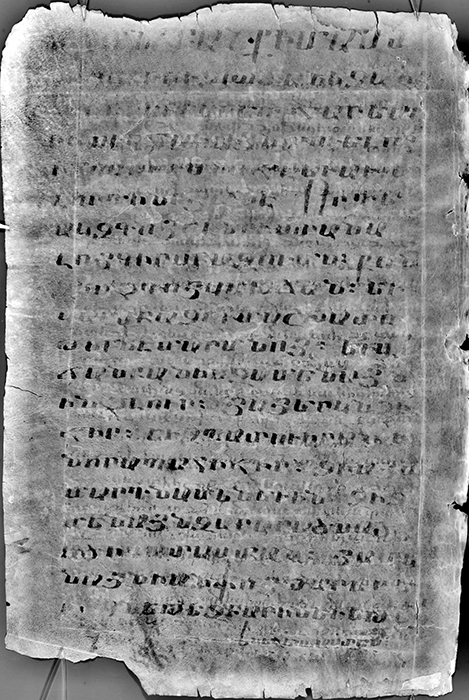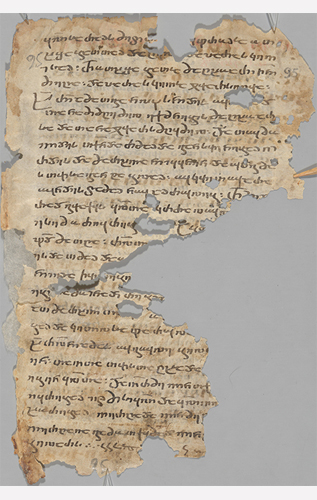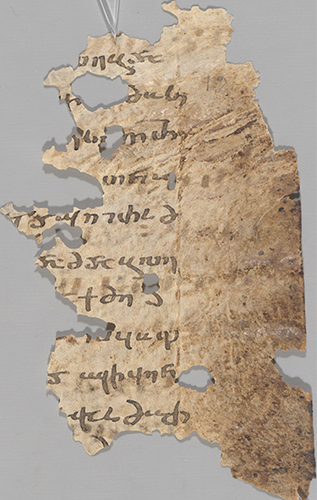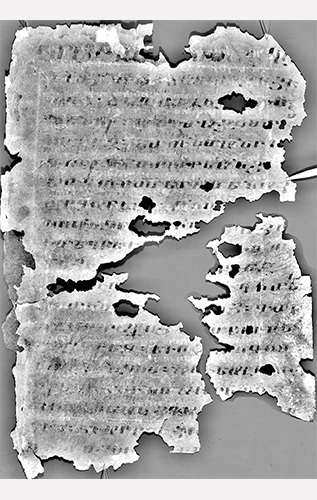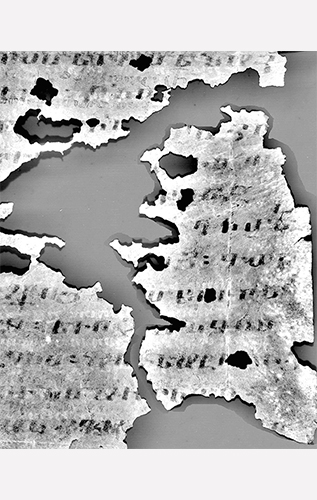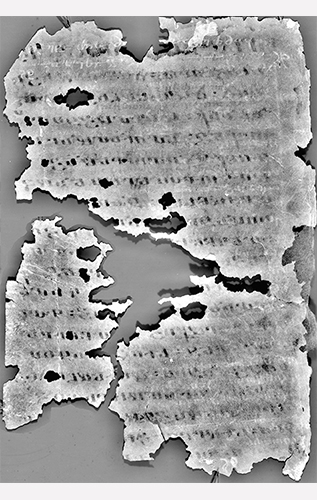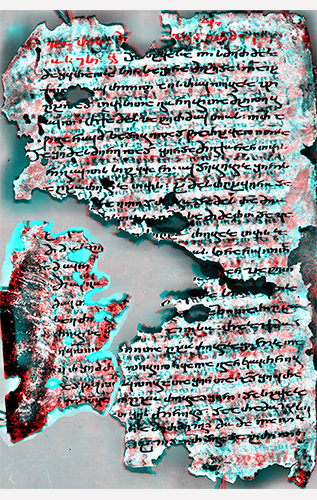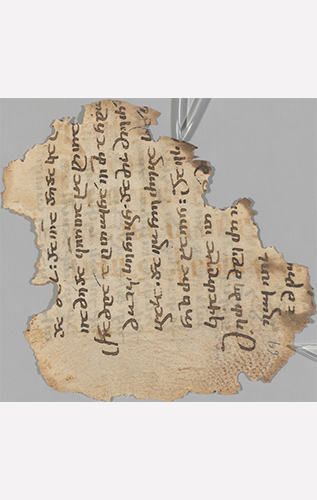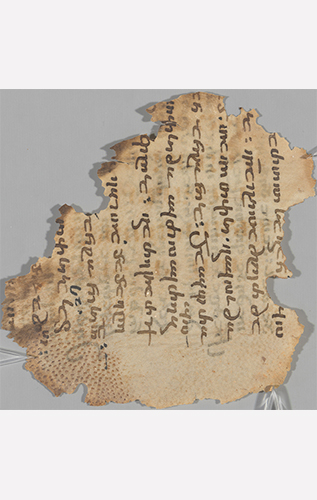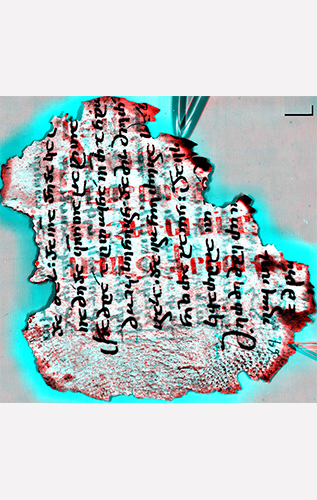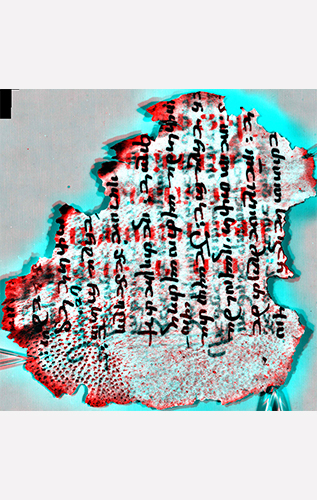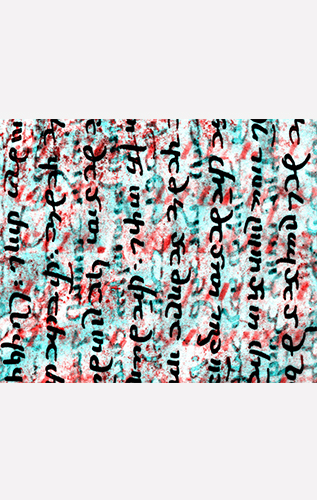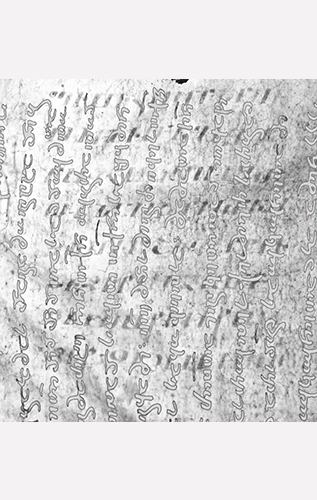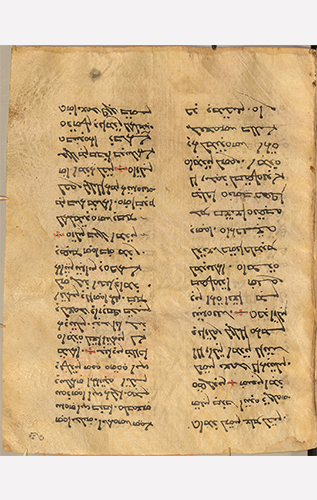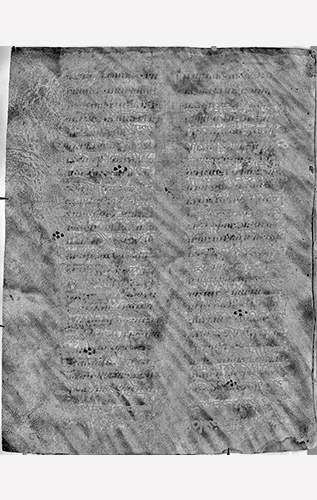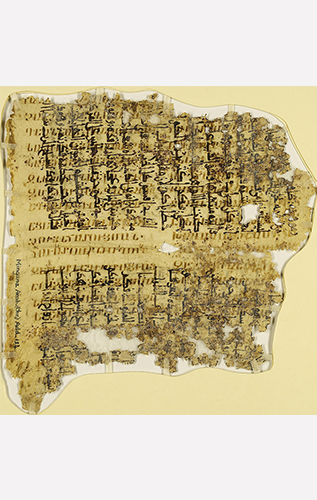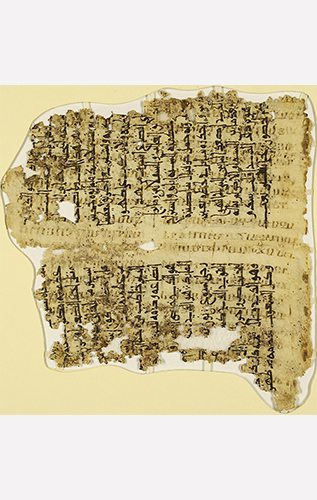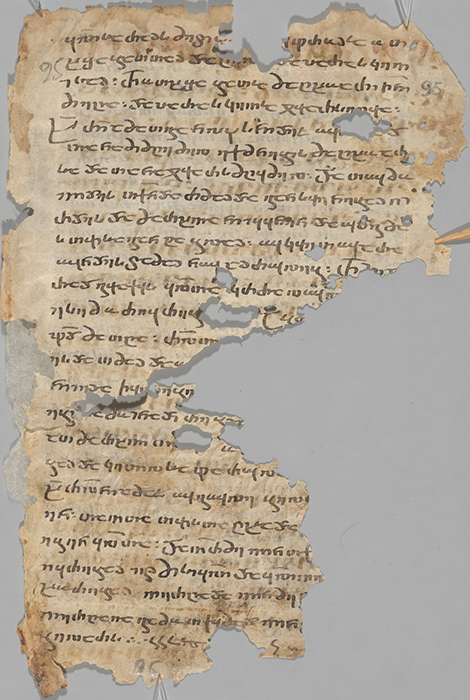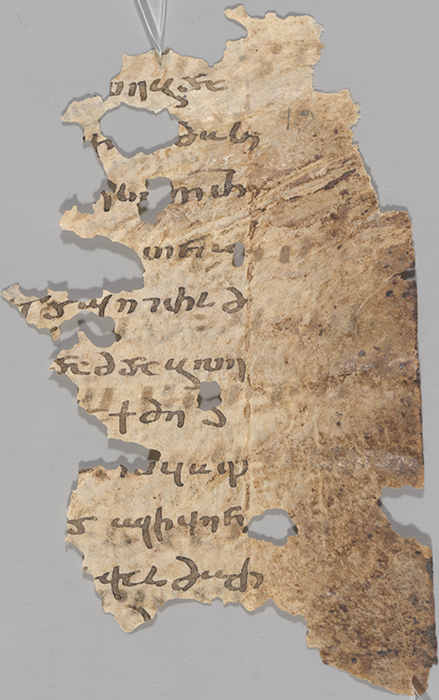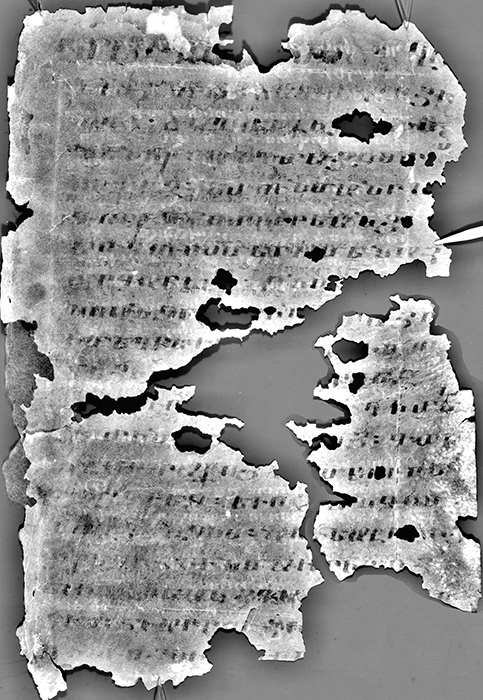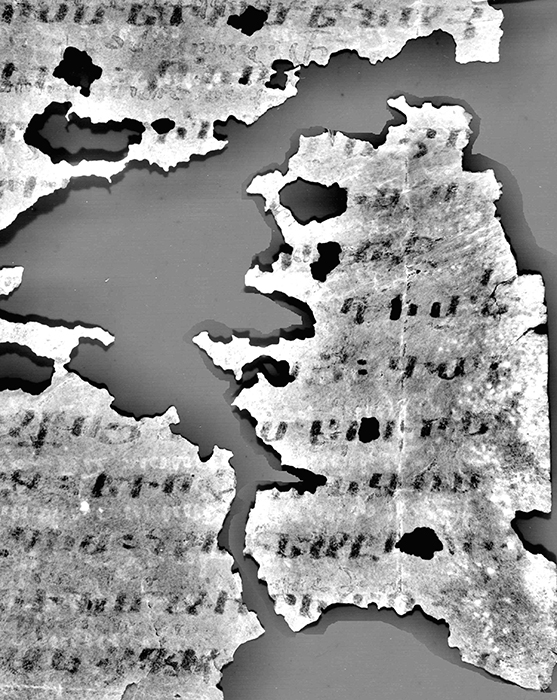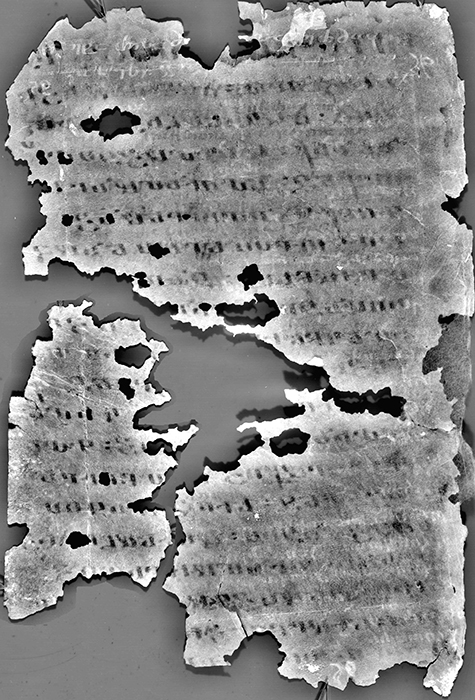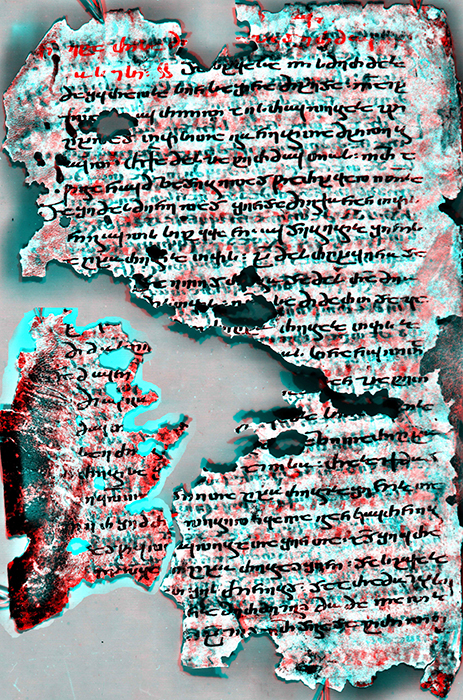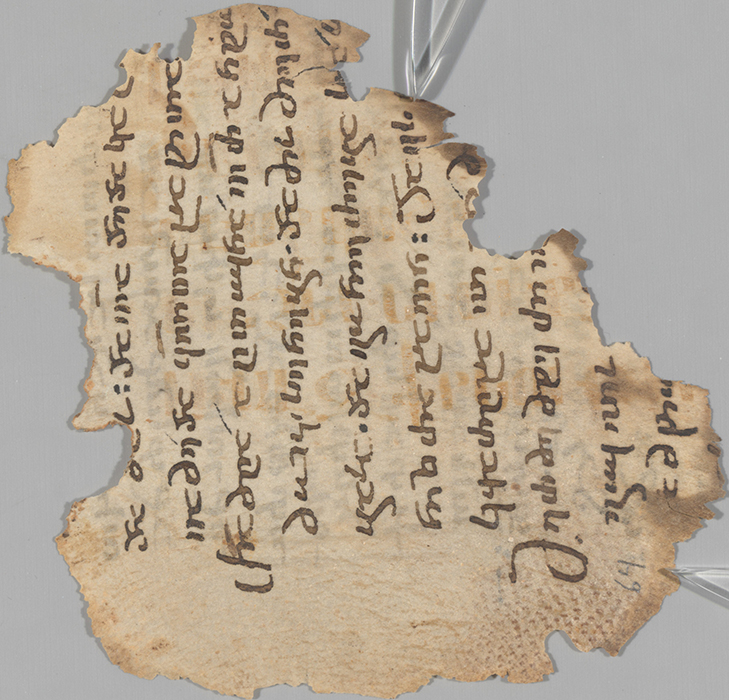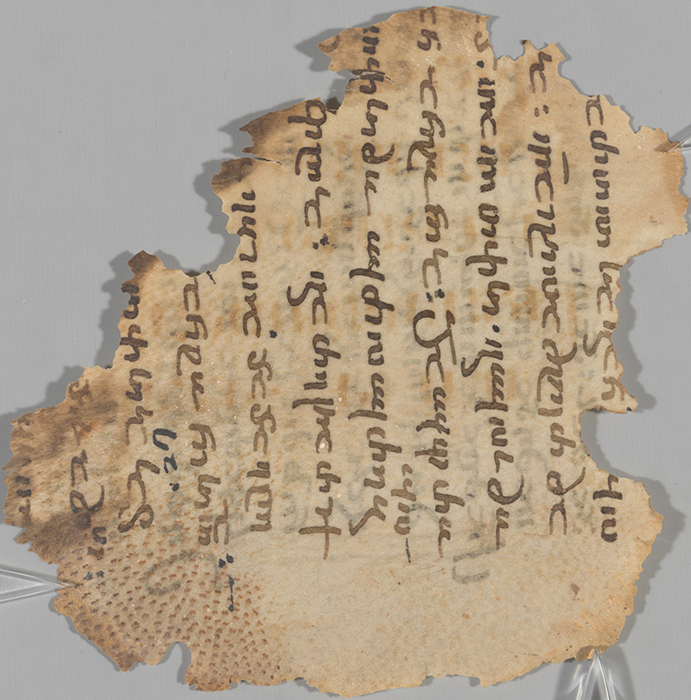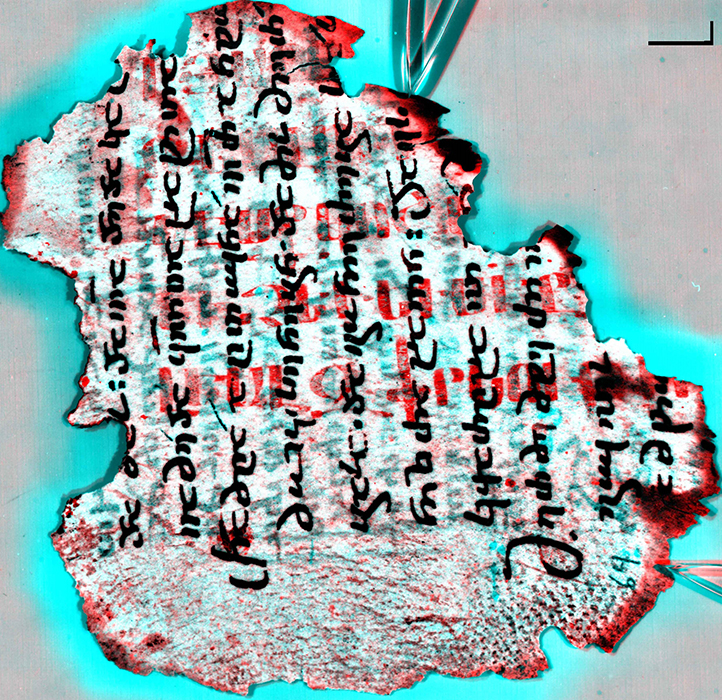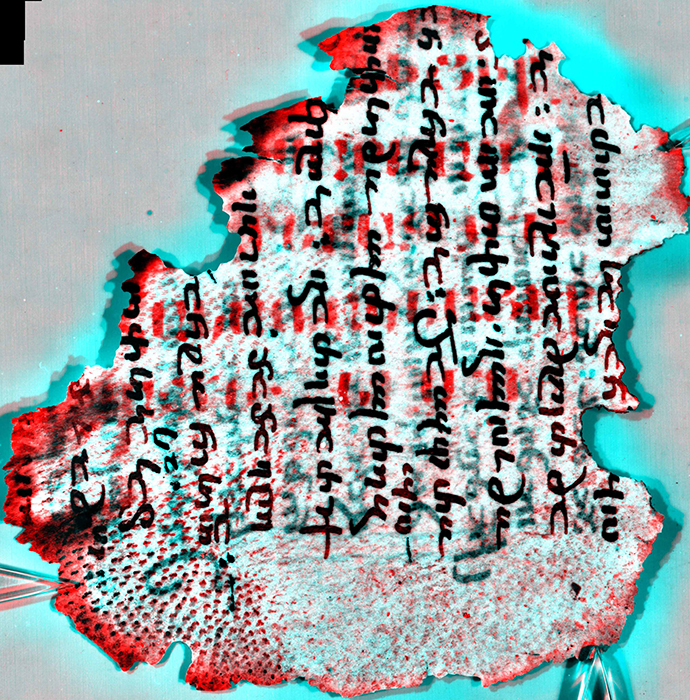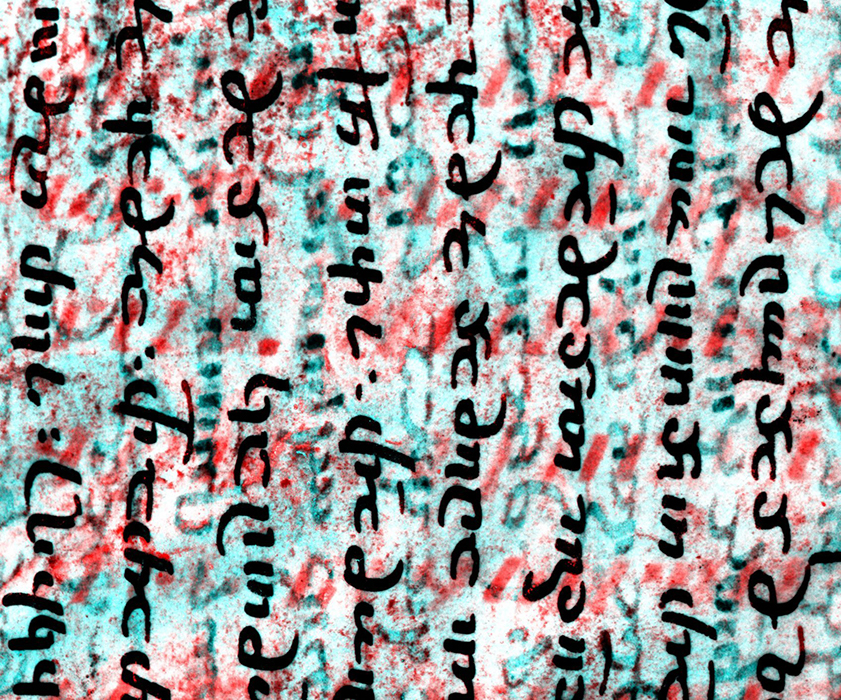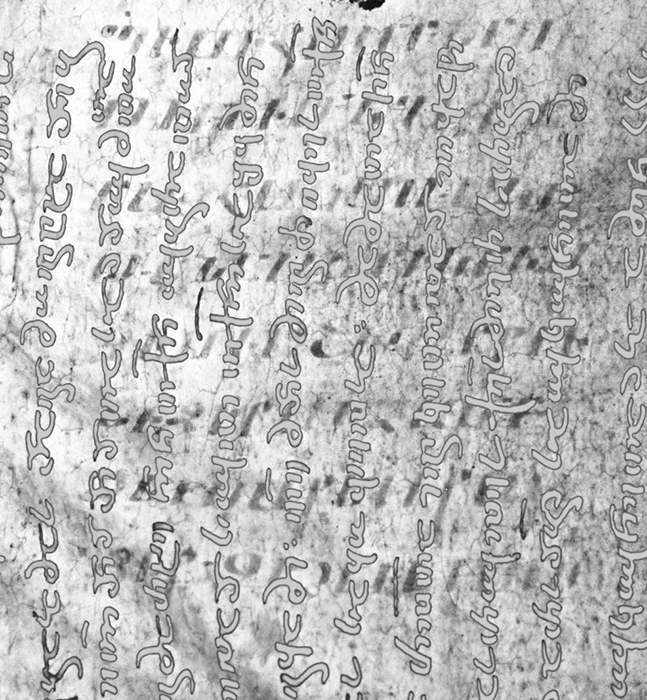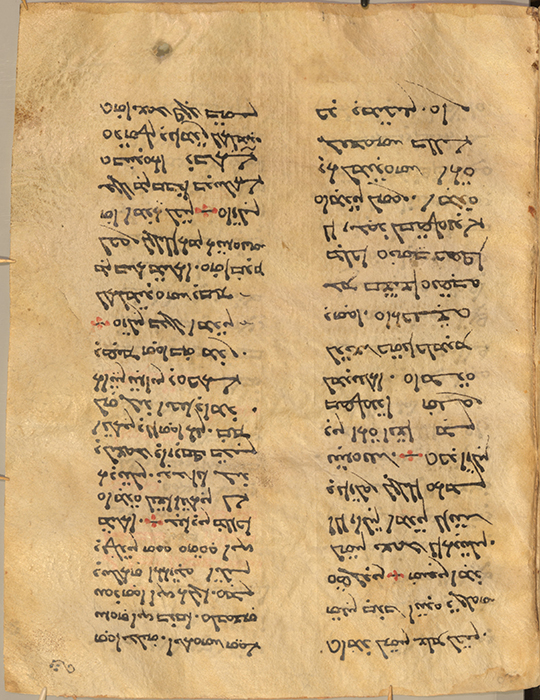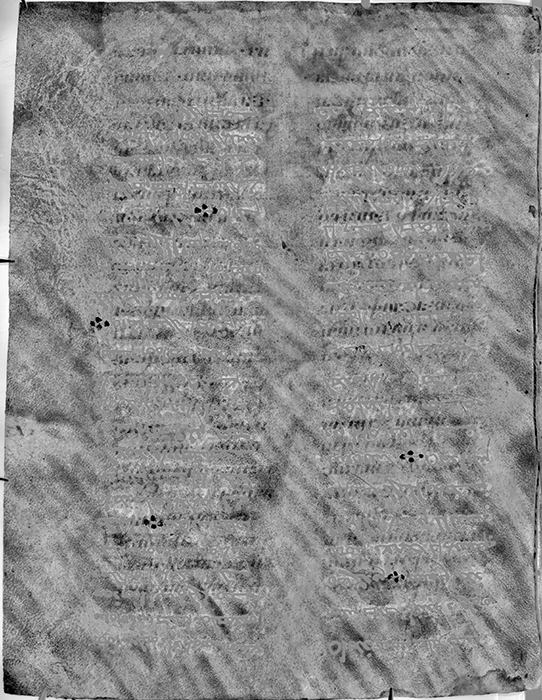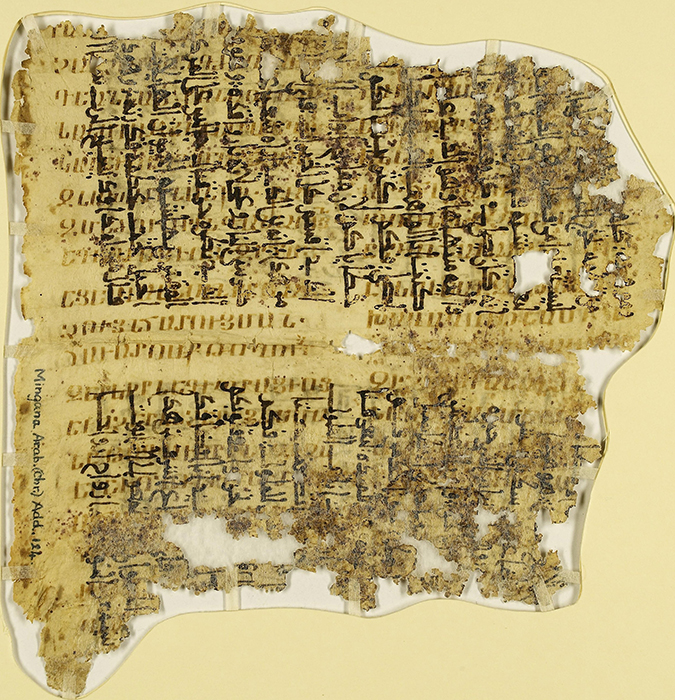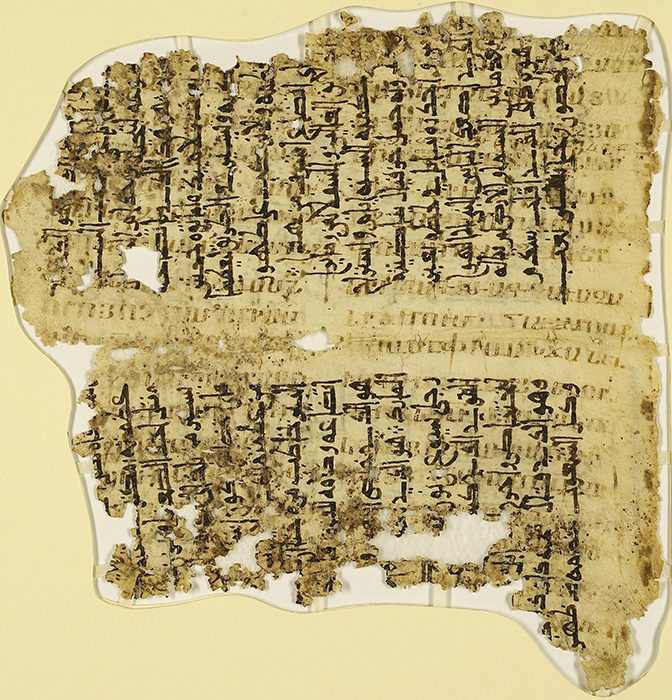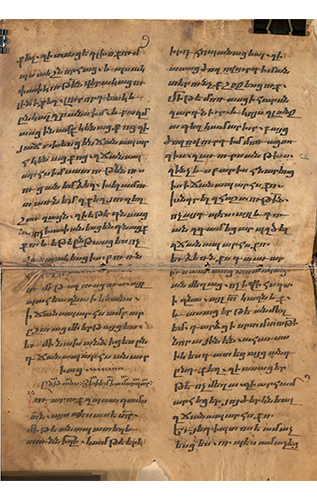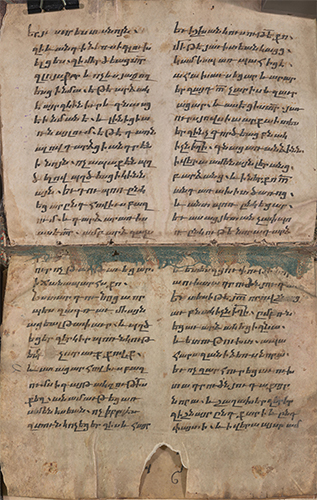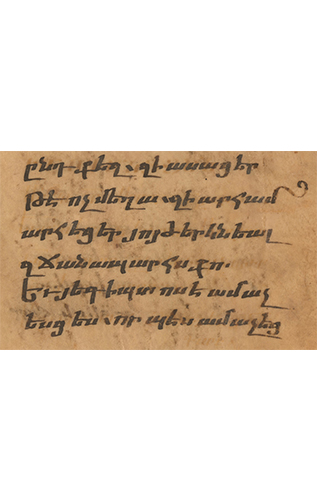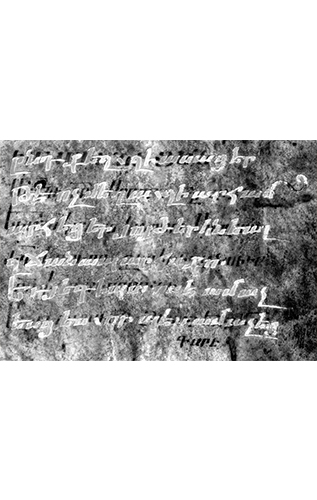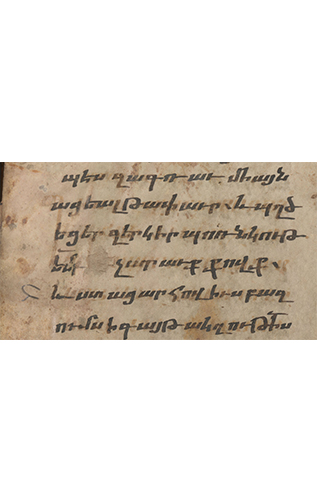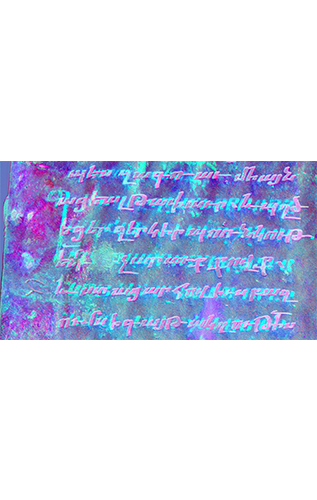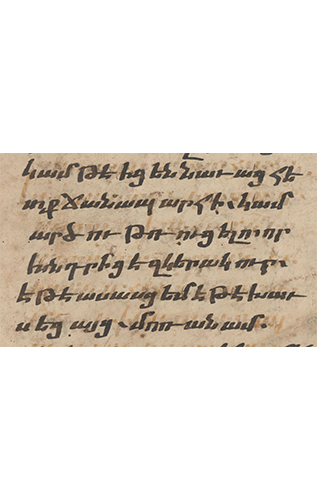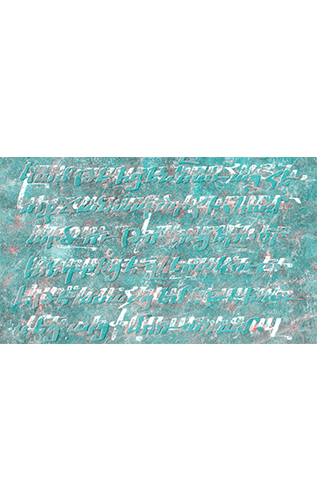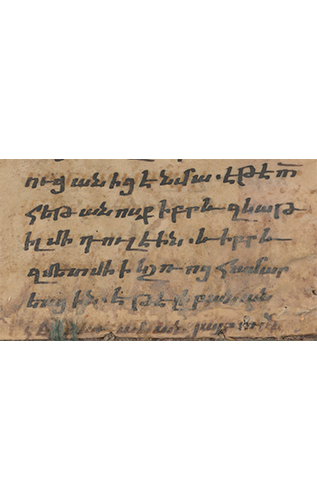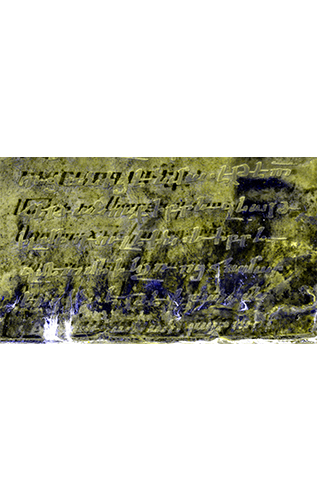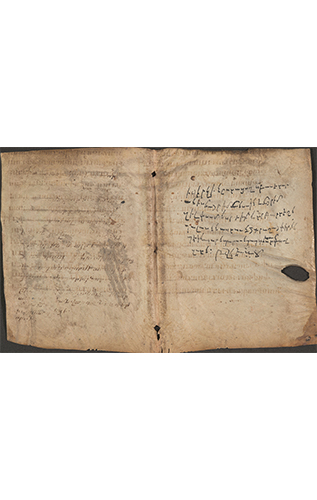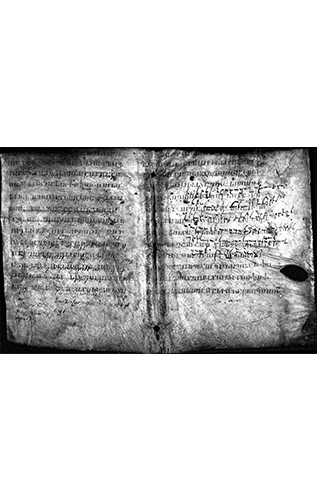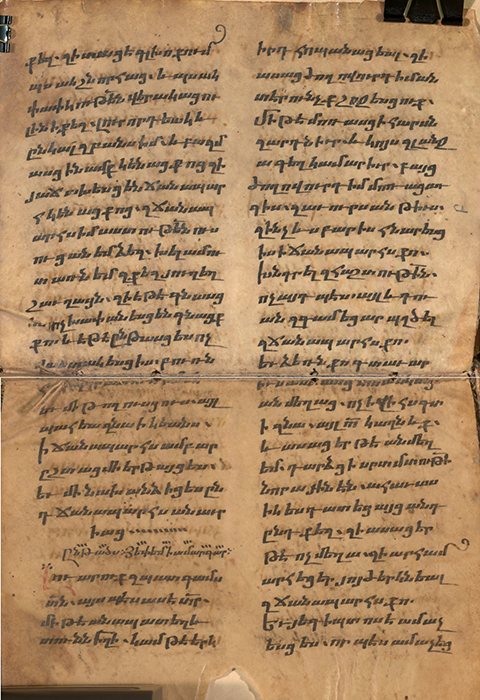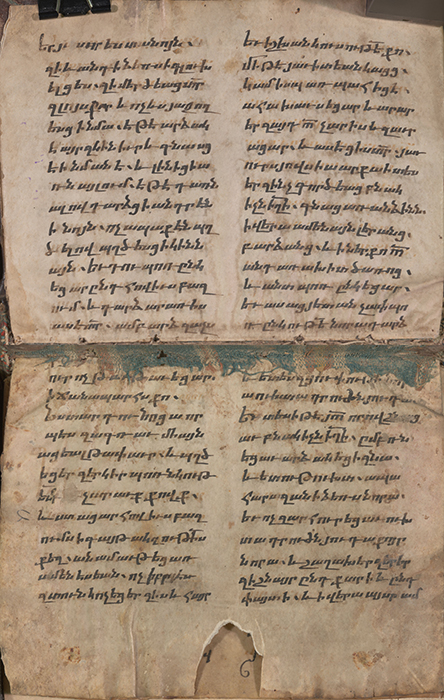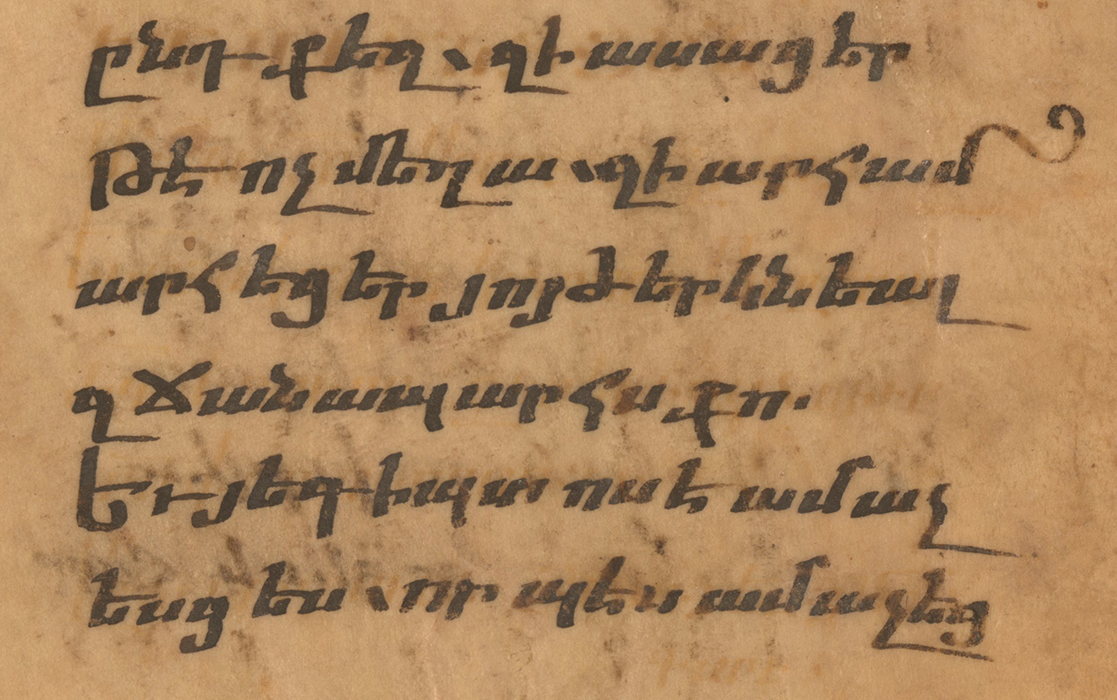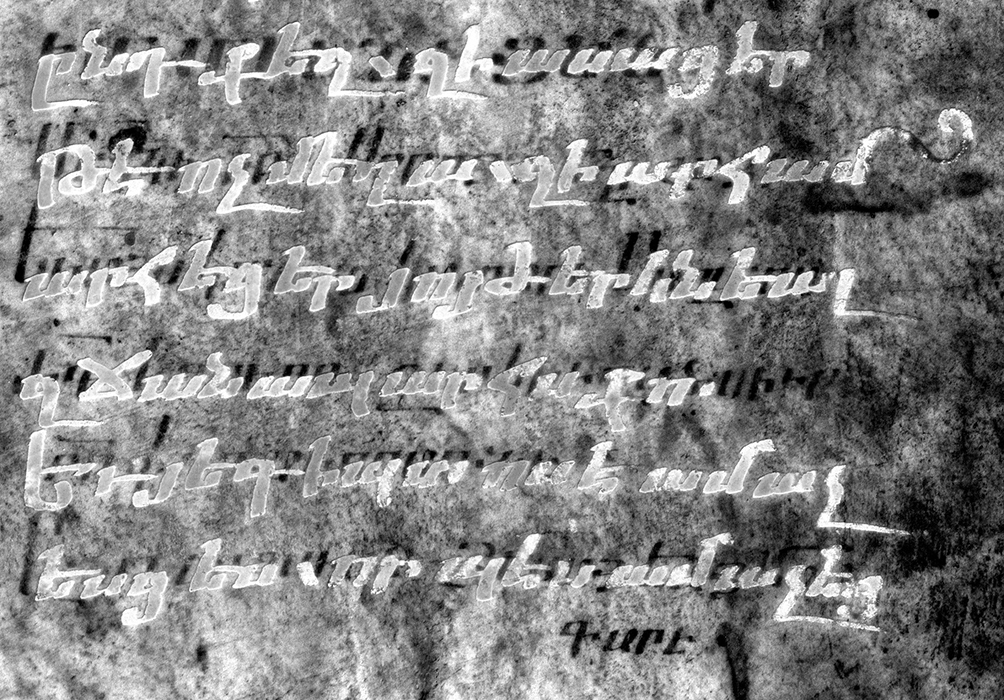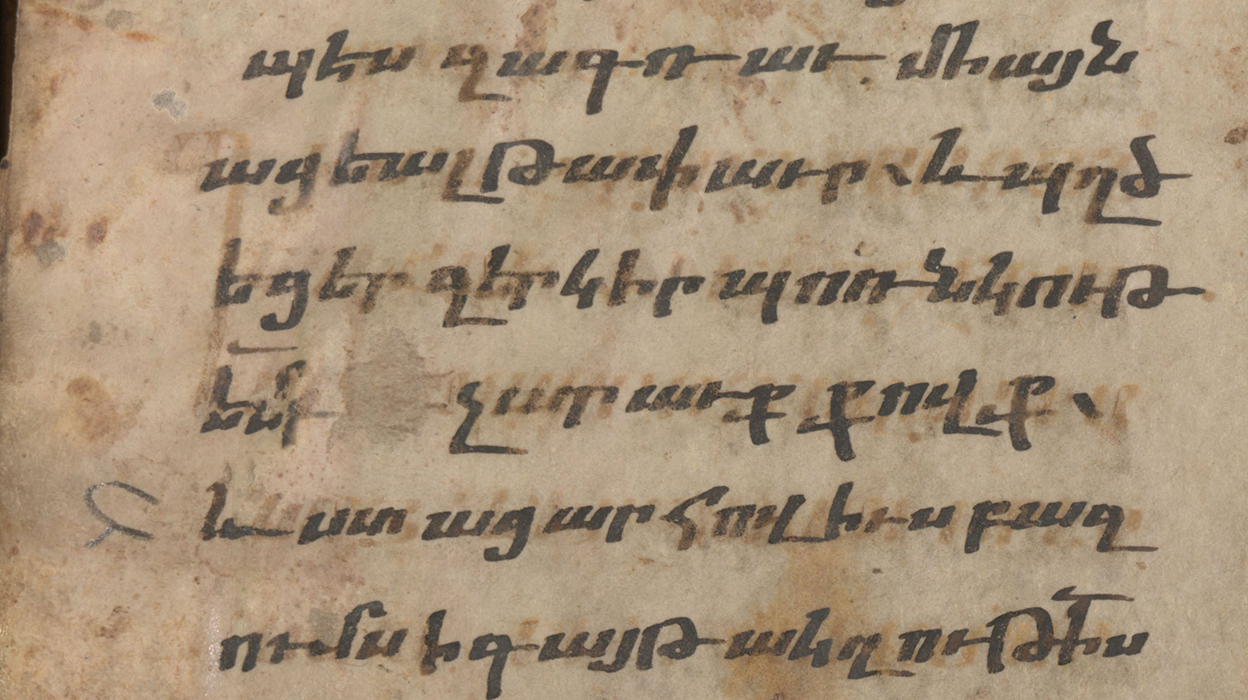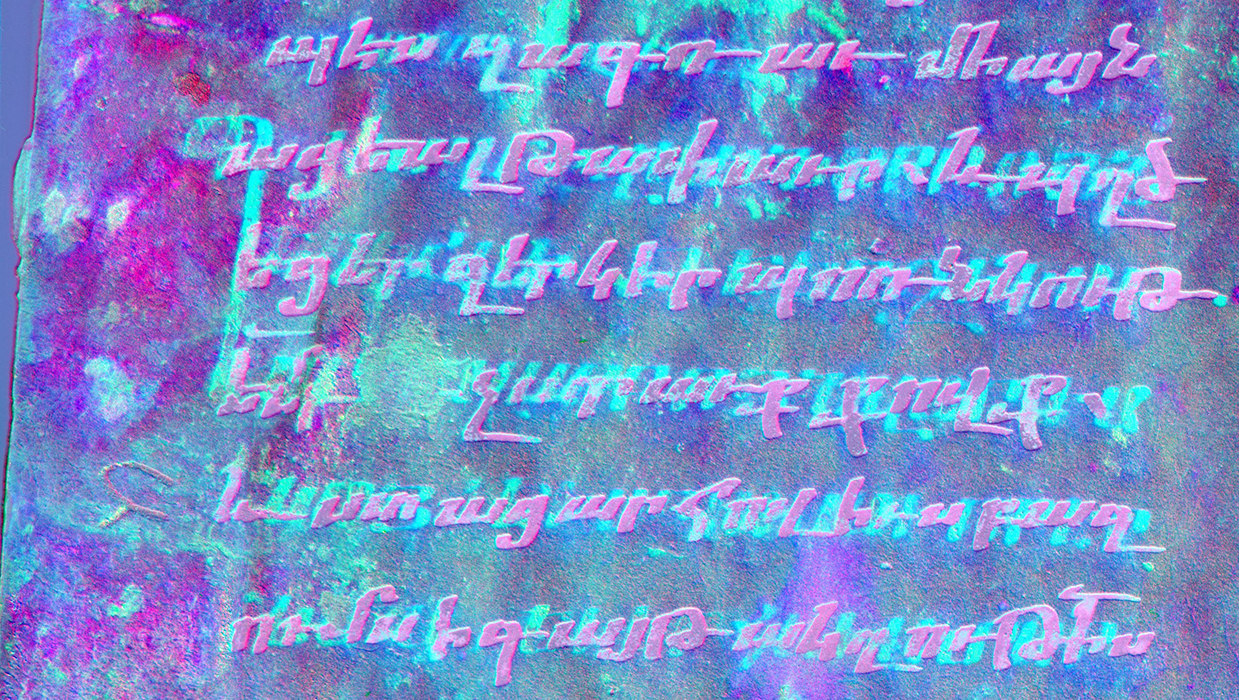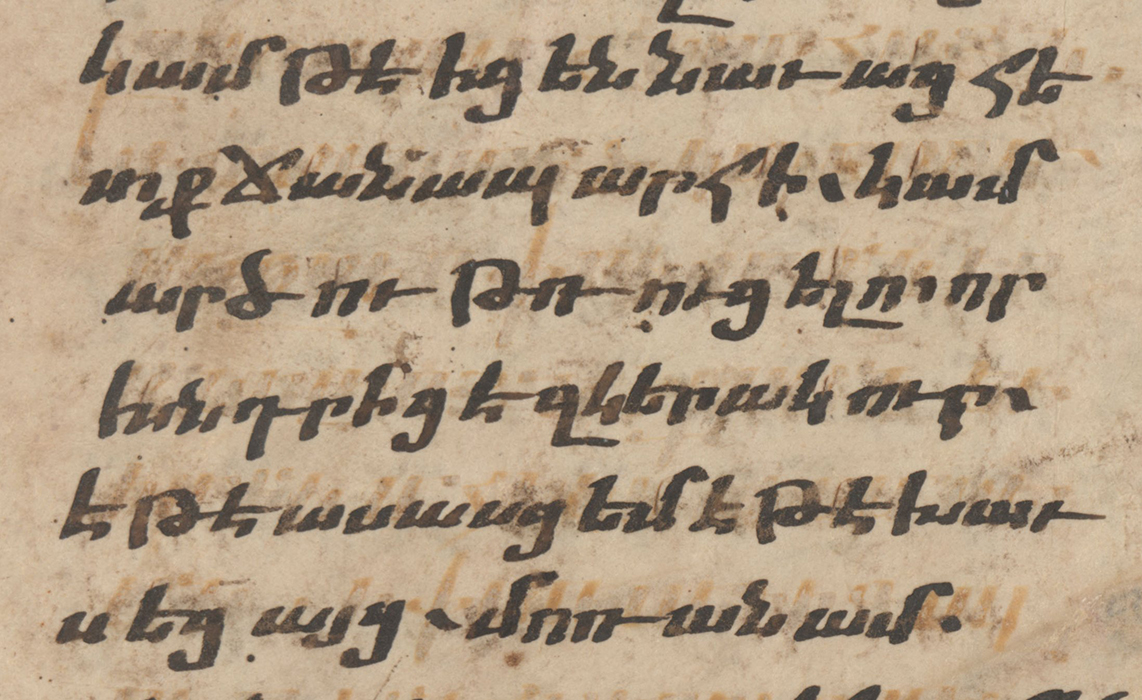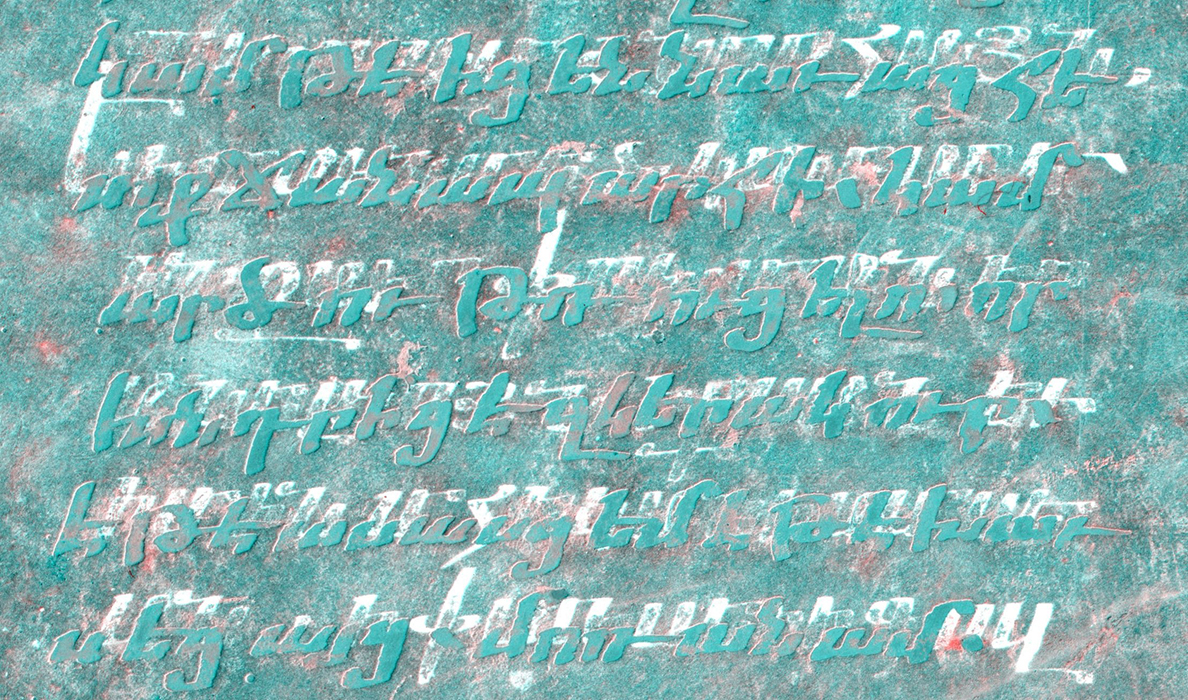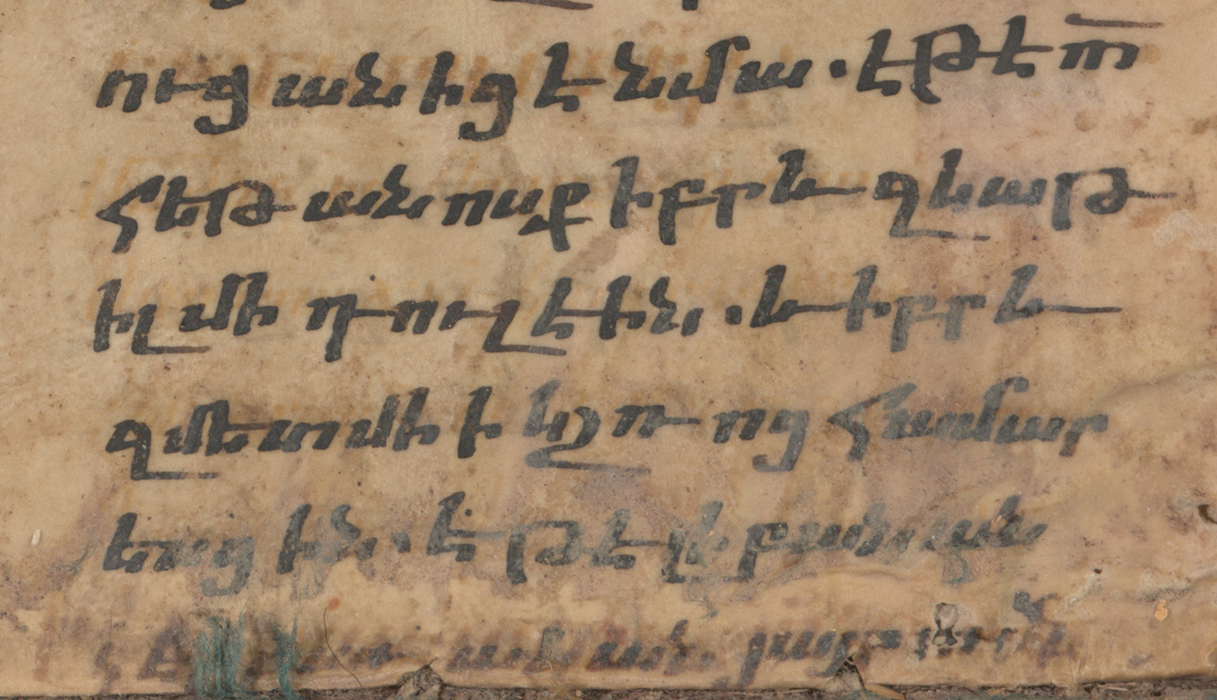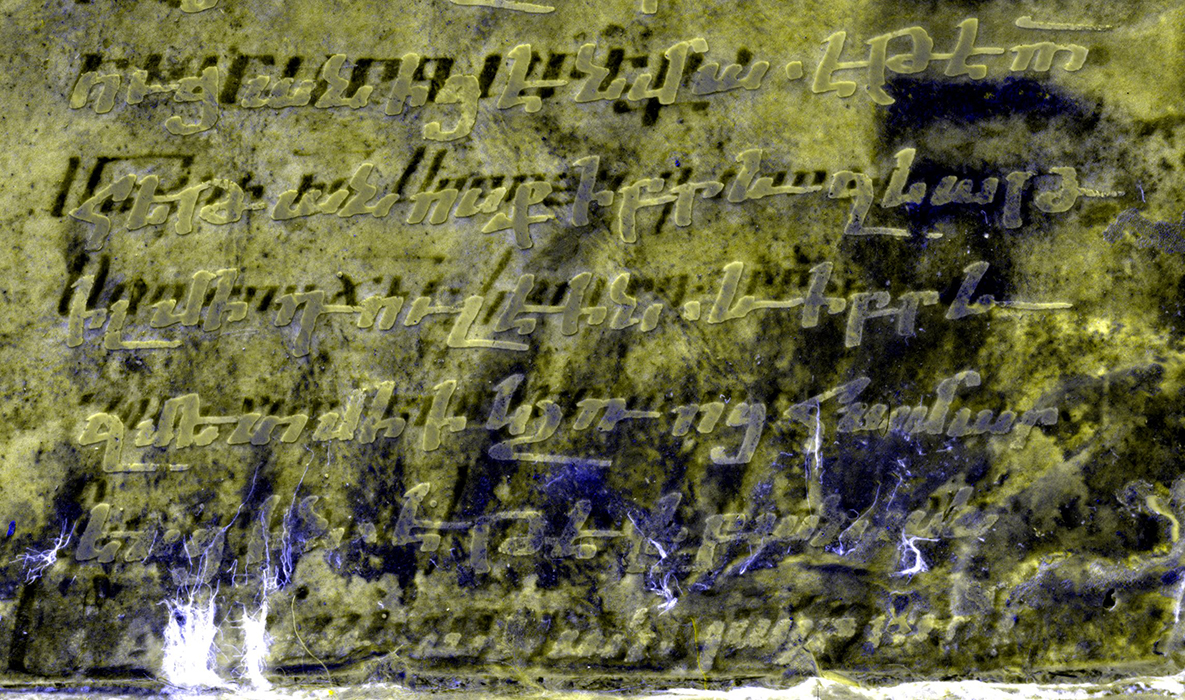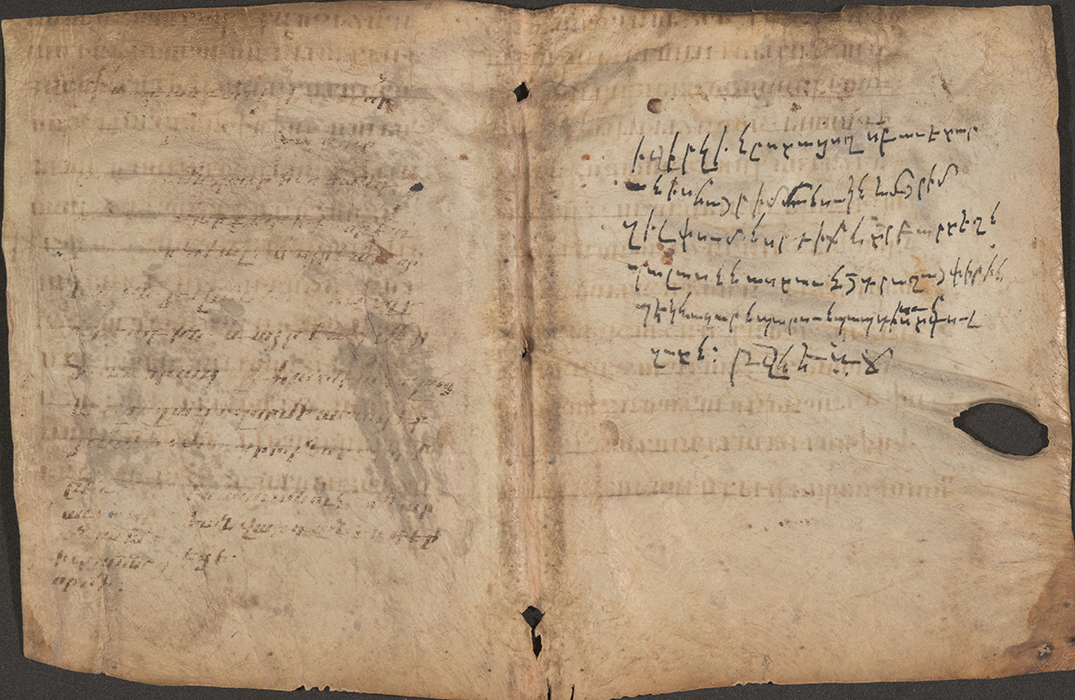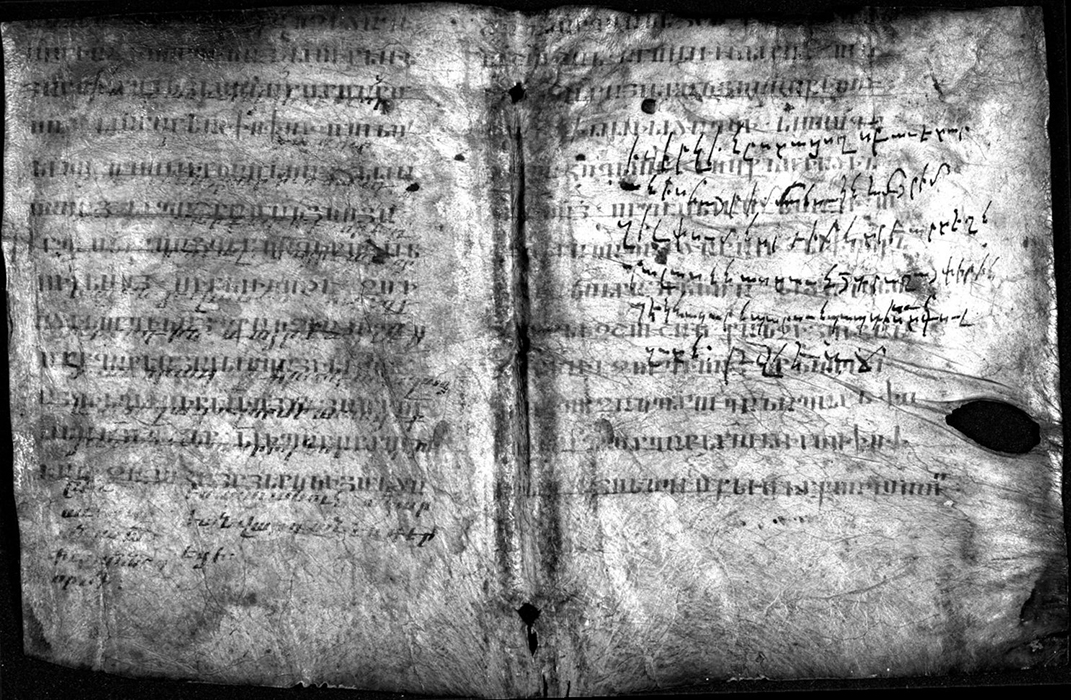Exploring Armenian Palimpsests with Multispectral and Transmissive Light Imaging [1]
The technological development of the recent past has brought about a lot of exciting new prospects for manuscript studies. This is especially true for the analysis of palimpsests, i.e. manuscripts (usually on parchment) that were written in early times but erased and overwritten in a later period. For the study of the overwritten undertexts, which are often much more valuable for philological and linguistic research than the later overtexts, the state of the art was for long determined by ultraviolet photographing, which may increase the contrast between the (whitish) support and the erased ink; however, with the introduction of multispectral imaging, the task of determining, deciphering, and editing the “lost” witnesses of early ages has gained much better ground.
W hen in 1975 a wall collapsed during a fire in St Catherine’s monastery on Mt Sinai, thus disclosing a hidden cellar room that contained hundreds of hitherto unknown manuscripts and fragments (the so-called “New Finds”), one of the most important discoveries consisted in two Georgian palimpsest codices whose lower layer appeared to be written in an unknown language and script. It took about 20 years until the undertext could be identified: the newly found palimpsests turned out to contain the only extant manuscript remains of the language of the Caucasian “Albanians”. Two international cooperation projects which ran from 1999 to 2008 were devoted to the decipherment and edition of the “Albanian” undertexts, [2] first on the basis of ultraviolet images and then by applying multispectral imaging. The efforts were successful, and as their result, a near-to complete edition of the Albanian texts contained in the palimpsests (Biblical texts from two different codices, one containing the Gospel of John and one, lectionary pericopes from the other Gospels, Epistles, and the prophet Isaiah; all in all 121 folios) was published in 2009. [3] However, the two Georgian palimpsests (mss. Sin. georg. NF 13 and NF 55) comprised not only Albanian materials in their lower layer but also, to a lesser extent, Old Armenian texts (all in all 42 folios). These, too, turned out to stem from two different original codices, one containing the Old Testament books attributed to King Solomon (Ecclesiastes, Canticum, and Sapientia) and the other, the Pauline Epistles with the Euthalian apparatus. Despite of a very restricted readability even under the conditions of multispectral imaging, the contents could be determined in great detail and published in a separate volume in 2010; [4] cf. Figures 1 – 4 showing one example each from the two Armenian codices in their present appearance and after applying multispectral imaging.
H owever, in many cases the degree of readability was by no means satisfactory. It was therefore highly welcome that in a subsequent project that was devoted to a complete capture of the palimpsests of St Catherine’s monastery, [5] a new technology was developed that makes it possible to extend the readability rate to a considerable extent. Multispectral imaging as applicable to palimpsest studies is mostly based on the analysis of the appearance of ink (pigments) at different wavelengths of the visible and invisible part of the spectrum and the combination and cross-calculation of different images, [6] thus allowing, e.g., to reduce the visibility of the overtext or to provide pseudo-colour images enhancing the contrast between the upper and the lower scripts, and these procedures have improved a lot since the first decade of this millennium; cf. Figures 5 – 6 showing pseudo-colour images of the examples introduced above. The most decisive step forward, however, was the development of a “transmissive light imaging” system, which makes use of the fact that the ink (usually iron gall) of the undertext “ate” into the parchment in the course of time so that the support became thinner wherever there was a character written. As a result, when a light source is placed underneath the parchment folio, the light shimmers through the thinner parts, thus yielding a much clearer picture of the undertext than any multispectral image could, given that the overtext does not appear in this case at all. Transmissive light imaging has one disadvantage which, however, is an advantage at the same time: Usually it is only one of the two sides of the parchment, the so-called flesh side, that is affected by the ink “eating” into it. This means that the light shimmering through affects only one of the two sides of the parchment folio (the flesh side); for the hair side, the technology usually adds nothing. On the other hand, it also means that the image of the flesh side is not disturbed by elements of the hair side. Of course the images thus produced can be further processed to yield a usual appearance; cf. Figures 7 – 8 for an example.
A nother by-product of the Sinai Palimpsests Project was the detection among the “New Finds” of a set of 19 unregistered fragments that could be proven to pertain to the two Georgian palimpsest manuscripts (which are, actually, the remnants of one Georgian codex). [7] Most of these fragments have turned out to bear undertexts in Caucasian Albanian again; [8] however, there at least two whose lower layer is Armenian. The first of them, now registered as fol. 61 of Sin. georg. NF 55, has proven to pertain to a damaged folio that had already been edited, namely, fol. 95 of Sin. georg. NF 13 containing the Old Testament text of Canticum 7.12–8.2 [9] (cf. Figures 9 – 10). The collage in Figures 11 and 12 shows where the fragment was originally located, the transmissive light image clearly displaying the text of the recto which represents the flesh side of the folio. The Bible text of Canticum 7.13–8.2 thus achieved can be rendered as follows, with green colour indicating the elements readable on Sin. georg. NF 13, fol. 95r, red colour, those on Sin. georg. NF 55, fol. 61r, and blue colour, elements that are still missing in the remaining gaps; the vertical stroke denotes line breaks. For easy comparison, the text of the Zohrab Bible is collated.
| No. | Sin. georg. NF 13, 95r + NF 55, 61r | Zohrab Bible |
|---|---|---|
| 7.13 | ետուն մանրագորք զհոտ իւրեանց ։ եւ | առ դուրս մեր ամենայն | մրգաբերք։ զնոր առ հ|նովն։ զոր ետ ինձ մայր | իմ եղբաւրորդի իմ պա|հեցի քեզ։ | Մանրագո՛րք ետուն զհոտ իւրեանց. եւ առ դուրս մեր ամենայն մրգաբերք։ Զնոր առ հնով, զոր ետ ինձ մայր իմ, պահեցի՛ քեզ եղբօրորդի իմ։ |
| 8.1 | ով տայր քեզ | եղբաւրորդի իմ դիտել | զստինս մաւր իմոյ։ գտե|ալ արտաքոյ համբուրե|ցից զքեզ։ եւ ոչ անգոս|նեսցես զիս | Ո՛վ տայր քեզ եղբօրորդի իմ դիտել զստինս մօր իմոյ։ Գտեալ արտաքոյ՝ համբուրեցի՛ց զքեզ, եւ ո՛չ անգոսնեսցես զիս։ |
| 8.2 | առեալ ածից | զքեզ ի տուն մաւր իմոյ | եւ ի սենեակ յղացելոյն | զիս ։ | Առեալ ածից զքեզ ՛ի տուն մօր իմոյ՝ եւ ՛ի սենեակ յղացելոյն զիս։ ... |
Of course, the verso of the two fragments is likewise joinable as shown in Fig. 13, and of course, the transmissive light image does not yield a readable text here as the verso represents the hair side of the given folio; the characters we see are those of the recto but mirrored. Under these conditions, we have to recur to multispectral images to reveal the undertext, which are much less clear than the transmissive light images of the recto (cf. Fig. 14) but clear enough to confirm that the verso fills the gaps in the text of Cant. 8.2–6 as established in the edition on the basis of Sin. georg. NF 13, fol. 95v. [10]
For the second new Armenian fragment, registered as fol. 64 of Sin. georg. NF 55 (cf. Figures 15 – 16), the pseudo-colour images of the Sinai Palimpsests Project (cf. Figures 17 – 18) are by all means sufficient to determine that the undertext the two sides contain is from St Paul’s letter to the Hebrews, covering Heb. 11.35 and 12.3–4, respectively. And indeed, it seems that the fragment immediately precedes the text of Sin. georg. NF 13, fol. 62v, [11] given that the latter begins with the last two words of Heb. 11.35, which are missing in Sin. georg. NF 55, fol. 64r; the constellation is illustrated below.
| No. | Sin. georg. NF 55, 64v + NF 13, 62v | Zohrab Bible |
|---|---|---|
| 11.35 | ընկալան կանայք ի յարութենէ զմե|ռեալս իւրեանց։ | Կէսք կոշկոճեցան' | եւ չեւեւս ընկա|լեալ զփրկութիւն, զի լաւագոյն յարութե(ան) հասանիցեն։ | ընկալան կանայք ՛ի յարութ(են)է զմեռեալս իւրեանց։ Կէսք կոշկոճեցան՝ եւ չե՛ւեւս ընկալեալ զփրկութի(ւն), զի լաւագո՛յն յարութե(ա)ն հասանիցեն։ |
Nevertheless, the fragment cannot belong to the palimpsested codex containing the Pauline Epistles from which Sin. georg. NF 13, fol. 62 is derived, for two reasons: on the one hand, the upright erkatʿagir script the fragment is written in is totally different from the slanted erkatʿagir of the folios of Sin. georg. NF 13 and NF 55 which contain the fragments from the epistles (cf. Figures 19 – 20 showing extracts of folios 62v and 63v of Sin. georg. NF 13 in pseudo-colour and transmissive light); on the other hand, the text of the fragment overlaps at least partly with the passage of Heb. 11.35–12.4 that has been preserved in the bifolio consisting of Sin. georg. NF 13, folios 62 and 63. To illustrate this, the two texts of Heb. 12.3–5 as appearing on Sin. georg. NF 55, fol. 64v and Sin. georg. NF 13, folios 63v–62r are rendered in parallel below.
| No. | Sin. georg. NF 55, 64b | Sin. georg. NF 13, 62v-62r | Zohrab Bible |
|---|---|---|---|
| 12.3 | ... լքանիցիք։ | | ... լքանի|ցիք . | ... լքանիցիք։ |
| 12.4 | զի չեւեւս արեամբ | չափ պատերազմե|ալք հակառակ կացէք | մեղացն . | զի չեւեւս արե||ամբ չափ պատե|ազմեալք հակա|ռակ կացէք մեղա|ցըն . | զի չե՛ւեւս արեամբ չափ ատերազմեալք՝ հակառակ կացէք մեղացն, |
| 12.5 | եւ մո|ռացարուք ... | եւ մոռացարուք ... | եւ մոռացարուք ... |
It was a surprise indeed to see that the new fragment, Sin. georg. NF 55, fol. 64, must have belonged to a third Armenian codex that was palimpsested on Mt Sinai and that this contained another version of the letter to the Hebrews. Remarkably enough, the given doublette is not the only one though. As a matter of fact, the Old Armenian passage of Heb. 11.25–38 occurs one more time among the Sinai palimpsests, namely, in the undertext of the Syriac manuscript Sin. syr. 7, fol. 47v (cf. Figures 21 – 22; fol. 48 of the same codex covers Heb. 10.21–35), and outside Mt Sinai, we find Heb. 11.14–33 in the fragment Chr. arab. Add. 124 of the Mingana collection in Birmingham (cf. Figures 23 – 24). [12] We thus have at least four palimpsested witnesses of chapters 10-12 of the book of Hebrews in Old Armenian at hand:
Sin. georg. NF 55, fol. 64: Heb. 11.35 and 12.4–5
Sin. georg. NF 13, folios 62+63: Heb. 11.35–12.7
Sin. syr. 7, folios 47+48: Heb. 10.21–35 and 11.25–38
Birmingham, Mingana Chr. arab. Add. 124: Heb. 11.14–33.
Considering that not yet very many Armenian palimpsests have been studied and published, this raises the question what rendered the book of Hebrews so apt for being erased and overwritten. One solution might consist in the fact that the book was positioned at the end of the Pauline Epistles (or at least those directed to the congregations), and thus possibly at the end of a given codex; a position from which individual folios or quires could easily dissolve. When the “isolated” folios resulting from this were not restored to the codex they stemmed from, they could be used for other purposes, including being palimpsested.
A s we have seen, St Catherine’s monastery is not the only place where Armenian palimpsests can be found. [13] In 2017, a new project was launched that is devoted to the palimpsests of the Matenadaran in Yerevan. [14] As a matter of fact, the actual number of palimpsested codices hosted in the Matenadaran has not yet been established with certainty; calculations differ from c. 50 palimpsest codices comprising ca. 1500 folios (official figure of the Matenadaran) and c. 1000 palimpsest manuscripts plus ca. 4500 fragments. [15] Since the beginning of the project, two complete codices (MM 1585 and 2130), many flyleaves (e.g., MM 470, 647, 1071, 1306) and some fragments have been processed with multispectral imaging; the transmissive light imaging system has only recently been installed and not yet produced any results. To provide an idea of what can be achieved here, I give just three examples.
Ms. MM 1306, a codex containing the Commentary on the Gospel of Matthew by Grigor Tatʿevacʿi, is bound with four flyleaves that are palimpsests (Armenian on Armenian). [16] Considering their upper text, which is written in bolorgir minuscules of c. the 11th–12th centuries, it is clear that the eight pages belong to one and the same codex, which contained a lectionary (čašocʿ) of the Jerusalem rite. The eight pages must be arranged in the order 3+2 – 4+1 | 7+6 – 8+5 (cf. Figures 25 – 26); they contain in their upper text lections for the Thursday and Friday of the 2nd and the Wednesday of the 3rd week of Lent. [17] The undertext is written in slightly slanted erkatʿagir majuscules of c. the 9th–10th centuries, arranged in two columns that were overwritten horizontally, which renders the decipherment rather difficult because the letters of the overtext cover those of the lower layer to a considerable extent. Nevertheless the content has been determined with certainty on the basis of the multispectral images produced: the undertext, too, represents a lectionary of the Jerusalem type, with Old and New Testament lections, psalms, and antiphons. This lectionary is peculiar, however, in that it also covers the lives of the saints that were commemorated on the given dates; except for these hagiographical texts and the psalms and antiphons, the contents coincide by and large with those of the lectionaries published so far. The actual dates covered are the 20th –23rd meheki (spelt mehki) with Ss Ełišē and George of Palestine being the saints commemorated. [18] The contents of the palimpsested flyleaves can be summarised as follows:
| Date | Psalm | OT lection | Vita | Apostols | Psalm | Gospel |
|---|---|---|---|---|---|---|
| 20th | Gal. 6.15–18 | (undet.) | Mt. 24.30–35 | |||
| 22nd | Ps. 14.4 | Is. 56.4–5 | St Ełišē | II Cor. 1.8–11 | 114.1 | Mt. 7.6–12 |
| 23rd | Ps. 117.1/6 | Os. 14.9–10 | (St George) |
To illustrate the arrangement of the lectionary and its wording, a few passages may suffice here.
On p. 2b, we read the end of Mt. 24.35, followed by the title for the 22nd mehki (cf. Figures 27 – 28): [19]
| Mt. 24.35 | (... երկինք եւ երկիր անցցեն եւ բանք) իմ մի անցցեն | (Heaven and earth will pass away and the words) of mine will not pass away. |
| Tit. 22nd mehki | Մեհկի ի՟բ Սրբոյն Եղիշայի Եւ այս կանոն կատարի Սաղմոս ժ՟դ Կցուրդ Զերկիւղածս իւր տ՟ր փառաւոր առնէ Ընթերցուած Յեսայեայ մար|գարէի [20] | Mehki, 22nd. Of St Ełisē. And thus the canon is exerted. Psalm 14 antiphon: ‘The Lord renders glorious those who fear him.’ Lection from Isaiah the Prophet. |
The vita of St Ełisē, which corresponds by and large to that published by Ł. Ališan, [21] begins on p. 1a with the following lines (cf. Figures 29 – 30):
| Պատմի վասն սրբոյն | “It was narrated on Saint |
| եղիշէի թե էր զինու | Ełišē that he was a milit- |
| որեալ սրբոյն վարդա | ant of Saint Vard- |
| նայ եւ սպասաւորէր… [22] | an, and he served...” |
The desinit of the vita on p. 6a is important as it explicitly provides the date of the 21st mhekani, thus differing in both the number and the denomination of the month from the title under which the text is subsumed; it reads (cf. Figures 31 – 32):
| Եւ տաւն մեծ կատարե | “And a big feast they perform- |
| ին զաւր փոխման եր | ed on the day of the mutation of the bl- |
| անելւոյն ի քսան եւ | essed, on the twenty and |
| ի մին մհեկանի ամսե | first of the mhekani mon- |
| ան ի փառս եւ ի գով | th, to the glory and the pr- |
| ութիւն հաւր… [23] | aise of the Father... |
The title for the 23rd mehki follows on p. 8b. It again coincides with that present in other lectionaries, except for the missing incipit of the Psalm; [24] this includes the erroneous reference to the prophet Joel (instead of Hosea). [25] The text reads (cf. Figures 33 – 34):
| Մեհկի ի՟գ Սրբոյն Գէորգեայ | Mehki, 23rd. Of St George. |
| Սաղմոս ճ՟ժէ Կցուրդ : տ՟ր է իմ աւգ | Psalm 117 antiphon: ‘The Lord is my he- |
| նական եւ ես ոչ երկնաց զի արաս | lper and I shall not fear. What will d- |
| ցէ ինձ մարդ Ընթերցու յովելի մագարգէ | o a man to me?’ Lection of Joel the Prophet. |
| Այսպէս ասէ տ՟ր Զի՞ եւս կ|(այ նորա ...) | ‘Thus speaks the Lord: What i|(s with them...)’ |
We may summarise that the flyleaves of ms. MM 1306 represent a very peculiar type of a lectionary, with saints’ lives accompanying the Biblical lections; [26] the vita of St Ełiše contained in it is probably the oldest witness of this text known so far. The lections agree with those of later lectionaries but the psalms (antiphons, alleluias) do not always.
The second example is the flyleaf of the miscellaneous codex MM 647, [27] a double leaf that has been deeply erased but only partially overwritten with a short letter [28] in a small cursive of c. the 19th century (cf. Figure 35 – 36). The undertext is written in an upright erkatʿagir of c. the 9th century; it represents a fragment of the (hitherto unpublished) Commentary on the Psalms by Theodoret of Cyrrhus, more exactly of the commentary on Ps. 44. A few lines may suffice again to illustrate the text, which is probably the most ancient witness available again: [29]
| … եւ արեալ փոփոխմունս | ... and performed changes |
| եւ նորոգութիւն ամենայն հեթա | and restoration of all hea- |
| նոսաց . եւ պաշտամանց նոցա : | thens and their services. |
| Որպէս եւ ասաց վերնագիրս թե | As also the title said that (it is the psalm) |
| սիրելւոյ սիրելի կոչէ . զմի | of the beloved one. Beloved is named the only be- |
| ածին որդին ա՟յ . քանզի այսպէս | gotten Son of God, for thus |
| մարգարեաց … | prophesised... |
Of course the palimpsests in the Matenadaran are not always in Armenian. E.g., the flyleaves of ms. MM 1071, a codex containing works by Mesrop Maštocʿ, [30] provide an overtext in Georgian written in a nuskhuri minuscule of c. the 15th century, which represents a fragment from a lectionary of the Constantinopolitan rite comprising lections for the Friday of the 6th week of Lent. [31] The undertext, too, is in Georgian but written in asomtavruli majuscules of c. the 9th century; it also represents a lectionary but of the older, Jerusalem, type. With lections of Ex. 4.19 – 6.13 and Joel 2.21–27 on the front flyleaf, it is assignable to the Thursday of the 3rd week of Lent. [32]
There is good reason to believe that by future work on the palimpsests of the Matenadaran, many further important witnesses of the first centuries of literacy in Armenia and the adjacent regions will come to light, now for the first time identifiable and analysable thanks to the technological progress we are witnessing.
References
- Ališan, Łevond (1901): Ղեվոնդ Ալիշան, Հայապատում. Պատմիչք և պատմութիւնք հայոց [հ. Ա]. Վենետիկ: Ս. Ղազար.
- Banouchyan, Arshak (2002): “The Armenian and Greek Fragments and Palimpsests of the Matenadaran collection”, in Dieter Harlfinger, Jana Grusková, Daniel Deckers, Koen Vanhaegendoren (eds), Rinascimento virtuale. Digitale Palimpsestforschung. Perspektiven des Netzwerks in den Beitrittsländern, Bratislava: Univerzita Komenská, 90–93.
- Brock, Sebastian P. (1965): “An Early Armenian Palimpsest Fragment of Hebrews”, Revue des études armeniennes, N.S. 2, 129–134.
- Brock, Sebastian P. (1969): “Notes on Some Texts in The Mingana Collection”, Journal of Semitic Studies 14 (2), 205–226.
- Eganyan, Ōnik / Zeytunyan, A. / Antabyan, P. (1965): Ցուցակ զեռագրաց Մաշտոցի անվան Մատենադարանի, հ. Ա, կազմեցին Օ. Եգանյան, Ա. Զեյթունյան, Փ. Անքաբյան. Երեվան: Հայկական ՍՍՌ Գիտությունների Ակադեմիայի հրատարակչություն / Каталог рукописей Матенадарана имени Маштоца, т. I, составили О. Еганян, А. Зейтунян, П. Антабян. Ереван: Издательство Академии Наук Армянской ССР.
- Eganyan, Ōnik (2007): Օ. Եգանյան, Մայր ցուցակ հայերեն ձեռագրաց Մաշտոցի անվան Մատենադարանի, հ. 3. Երեվան: Մատենադարան.
- Eganyan, Ōnik (2008): Օ. Եգանյան, Մայր ցուցակ հայերեն ձեռագրաց Մաշտոցի անվան Մատենադարանի, հ. 4. Երեվան: Մատենադարան.
- Gigineišvili, Bakar / Giunašvili, Elguǯa (1979): შატბერდის კრებული X საუკუნისა. გამოსაცემად მოამზადეს ბ. გიგინეიშვილმა და ელ. გიუნაშვილმა. თბილისი: მეცნიერება / Шатбердский сборник X века, подготовили к изданию Б. К. Гигинеишвили и Э. А. Гиунашвили. Тбиилси: Мецниереба.
- Gippert, Jost (2007): “The Application of Multispectral Imaging in the Study of Caucasian Palimpsests”, Bulletin of the Georgian National Academy of Sciences /საქართველოს მეცნიერებათა ეროვნული აკადემიის მოამბე 175 (1), 2007, p. 168–179.
- Gippert, Jost (2010): The Caucasian Albanian Palimpsests of Mount Sinai. Vol. III: The Armenian Layer, Turnhout: Brepols (Monumenta Palaeographica Medii Aevi, Series ibero-caucasica, 2/3).
- Gippert, Jost (2020): “An Early Witness of the Armenian Lectionary”, in: Bernard Outtier, Cornelia B. Horn, Basil Lourie, Alexey Ostrovsky (eds), Armenia between Byzantium and the Orient. Celebrating the Memory of Karen Yuzbashian (1927–2009), Leiden: Brill, 97–111.
- Gippert, Jost (forthcoming): “New Light on the Caucasian Albanian Palimpsests of St. Catherine’s Monastery”, in: Claudia Rapp, Jana Gruskova, Grigory Kessel, Giulia Rossetto (eds), New Light on Old Manuscripts: Recent Advances in Palimpsest Studies. Vienna.
- Gippert, Jost / Sarjveladze, Zurab / Kajaia, Lamara (2007): The Old Georgian Palimpsest Codex Vindobonensis georgicus 2, Turnhout: Brepols 2007 (Monumenta Palaeographica Medii Aevi, Series ibero-caucasica, 1).
- Gippert Jost / Schulze Wolfgang / Aleksidze Zaza / Mahé Jean-Pierre (2009): The Caucasian Albanian Palimpsests of Mount Sinai. I–II. Turnhout: Brepols (Monumenta Palaeographica Medii Aevi, Series ibero-caucasica, 2/1 and 2/2).
- Mingana, Alphonse (1939): Catalogue of the Mingana Collection of Manuscripts. III: Additional Christian Arabic and Syriac Manuscripts. Cambridge: Heffer and Sons.
- Renhart, Erich (2015): Ein spätantikes Los-Buch. Die Handschrift 2058/2 der Universitätsbibliothek Graz – ein armenisches Palimpsest. Graz: Unipress-Graz.
- Renoux, Charles / Sirinian, Anna (2018): Una nuova tappa del čašocʿ (lezionario armeno). Il manoscritto Arch. Cap. S. Pietro B 77. Città del Vaticano: Biblioteca apostolica vaticana (Studi e testi, 524).
- Tarchnischvili, Michel (1959): Le grand lectionnaire de l’église de Jérusalem. I. Louvain: Secrétariat du CorpusSCO (Corpus scriptorum christianorum orientalium, 188; Scriptores iberici, 9)
Footnotes
- This publication is part of a project that has received funding from the Volkswagen Foundation (project 'Palimpsest Manuscripts of the Matenadaran', grant no. 93304), from the European Research Council (ERC) under the European Union’s Horizon 2020 research and innovation programme (Grant agreement No. 101019006) and from the Deutsche Forschungsgemeinschaft (DFG, German Research Foundation) under Germany’s Excellence Strategy – EXC 2176 ‘Understanding Written Artefacts: Material, Interaction and Transmission in Manuscript Cultures’ (Project No. 390893796). A preliminary version of the present paper was read on the international conference “Digital Armenian” in Paris, 4.10.2019.
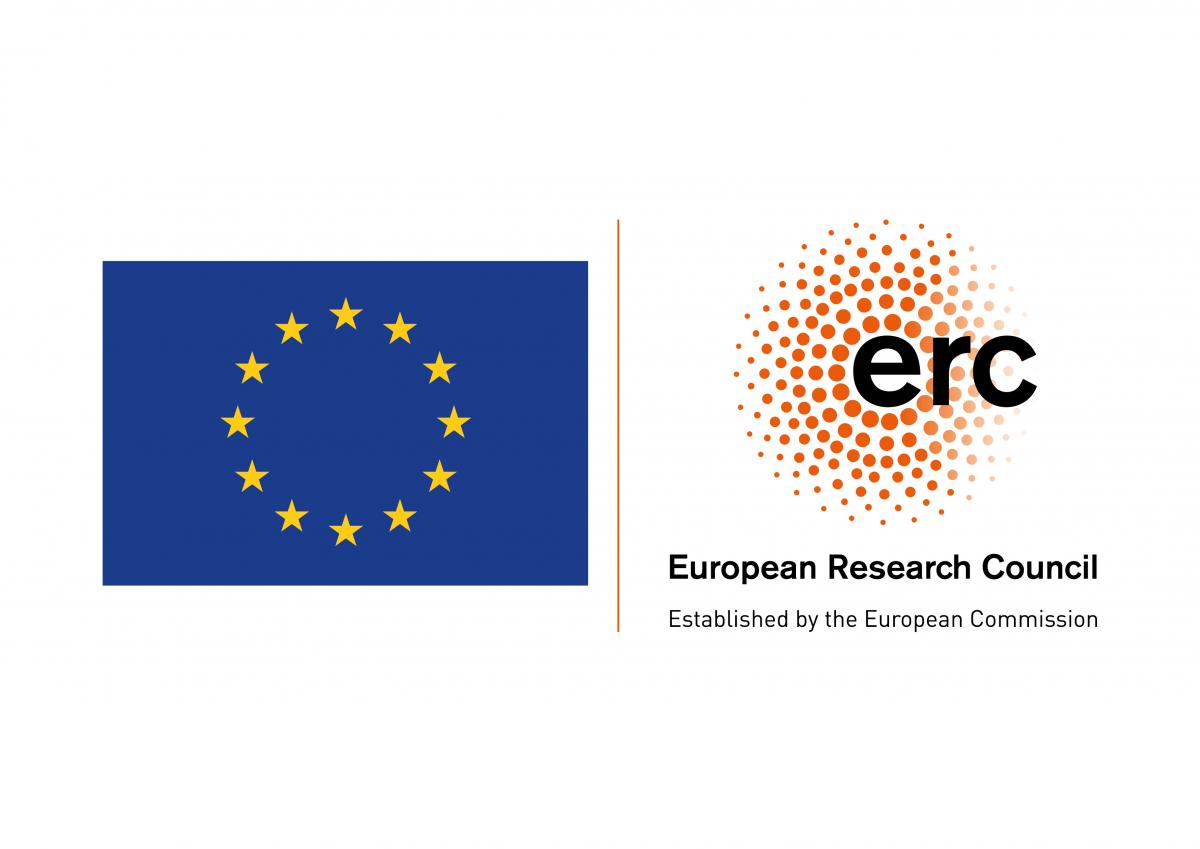

- The projects “Caucasian Languages and Cultures: Electronic Documentation” (ARMAZI), 1999–2002, and “Palimpsest Manuscripts of Caucasian Provenance”, 2003–2008, both kindly funded by the Volkswagen Foundation. My thanks are due to Zaza Aleksidze and Jean-Pierre Mahé, who instigated the projects, Giorgi Aleksidze, who provided some of the photographs dealt with below, and Wolfgang Schulze and Manana Tandashvili with whom I cooperated most in the decipherment.
- Gippert et al. (2009).
- Gippert (2010).
- The “Sinai Palimpsests Project”, cf. sinaipalimpsests.org. My thanks are due to Claudia Rapp, Michael Phelps and their team who provided the photographs dealt with below.
- Cf. Gippert (2007a: xxxii–xxxiv) and Gippert (2007b: 168–179) for details as to the methods implied.
- Cf. Gippert et al. (2009: I-3–5) for details.
- Cf. Gippert (forthc., [8–12]) for details.
- Cf. Gippert (2010: IV-48–51).
- Cf. Gippert (2010: IV-50–51).
- Cf. Gippert (2010: III-14–15).
- The images are provided by the University of Birmingham together with a description on epapers.bham.ac.uk/91/. The content was first determined as Heb. 11.15–32 by S. P. Brock (1965: 129–134 and 1969: 224 with n. 6). The faulty notion on the web page that the underwriting is “a legal text (?) in Armenian” is obviously based upon Mingana (1939: 20), who states under no. 166: “Under-Writing: Not Biblical. Possibly the fragment of a legal code”.
- Other examples are ms. 2058/2 of the University Library of Graz, Austria, an important Georgian psalter codex with an Armenian underwriting comprising Biblical texts (from the Gospel of John) but also a set of nearly 300 fate-telling sentences (“Lossprüche”; cf. Renhart 2015) or ms. EBE 637 of the National Library of Greece, Athens, a Greek palimpsest codex containing in its undertext fragments from the Old Armenian lectionary of the Jerusalem rite (cf. Gippert, 2020).
- The project was kindly funded by the Volkswagen Foundation from 2017 to 2022. My thanks are due to Vahan Ter-Ghevondyan, Gevorg Ter-Vardanyan, Gurgen Gasparyan and their team of the Matenadaran who provided the images dealt with below, and Ivan Shevchuk of the Centre for the Study of Manuscript Cultures, Hamburg, who shared his expertise with us.
- Banouchyan (2002).
- Cf. Eganyan et al. (1965: col. 522 and 2008: no. 1306).
- More precisely: pp. 3+2 and 4+1: Jer. 2.31–36 + 2.37–3.6–10, from a lection covering Jer. 2.31–3.16 for the Thursday; pp. 7+6 and 8+5: Job 9.20–32 from a lection covering 9.2–10.2 and Is. 40.9–17 for the Friday of the 2nd week; Ex. 2.23 from a lection covering 2.23–3.15 for the Wednesday of the 3rd week.
- Cf. Renoux / Sirinian (2018: 162) for the same period as covered in ms. Arch. Cap. S. Pietro B 77 of the Bibliotheca Apostolica Vaticana.
- Ms. Arch. Cap. S. Pietro B 77, fol. 227rb names by error the 11th instead of the 21st meheki; cf. Renoux / Sirinian (2018: 162 with n. 555) and the image provided by the BAV in digi.vatlib.it/pub/digit/MSS_Arch.Cap.S.Pietro.B.77/iiif/Arch.Cap.S.Pietro.B.77_0459_fa_0227r.jp2/full/1163,/0/native.jpg. Cf. below as to the date.
- Except for the difference in the date, ms. Arch. Cap. S. Pietro B 77, fol. 227rb has meheki instead of mehki, ełišei vardapeti instead of srboyn ełišei, and omits the number of the psalm.
- Ališan (1901: 430–434).
- Ališan has eranelwoyn Ełišēi vardapeti instead of srboyn ełišēi. Whether or not the addition of the title vardapet is significant for the dating has still to be explored.
- The text published by Ališan (1901: 434) is much shorter here, not giving the date at all: ew tōn mec awangēin zōr katarman Eranelwoyn, i pʿars ew i govowtʿiwn hōr...
- Ms. Arch. Cap. S. Pietro B 77, fol. 228r gives xostovan as the incipit, thus determining the Psalm as 117.1.
- Cf. Renoux / Sirinian (2018: 162 no. [167]).
- Ch. Renoux, specialist of the lectionary tradition, kindly confirms: “Ce n'est que rarement que j'ai rencontré des Vies parmi les lectures” (e-mail of 12th Sept., 2019).
- Cf. Eganyan et al. (1965: col. 372).
- Cf. Eganyan et al. (2007: no. 647).
- The passage corresponds to that of the Georgian version in the so-called Shatberd codex (ms. S-1141 of the Korneli Kekelidze National Centre of Manuscripts, Tbilisi), cf. Gigineishvili / Giunashvili (1979: 389, ll. 12–16).
- Cf. Eganyan et al. (1965: col. 469).
- More precisely, Gen. 50.17–25, Ps. 124.1 + 2, and Prov. 31.8–17.
- It matches nos. 414 and 416 of the so-called “Paris Lectionary”, cf. Tarchnischvili (1959: 69).
Image credits:
Jost Gippert, Centre for the Study of Manuscript Cultures, Hamburg
